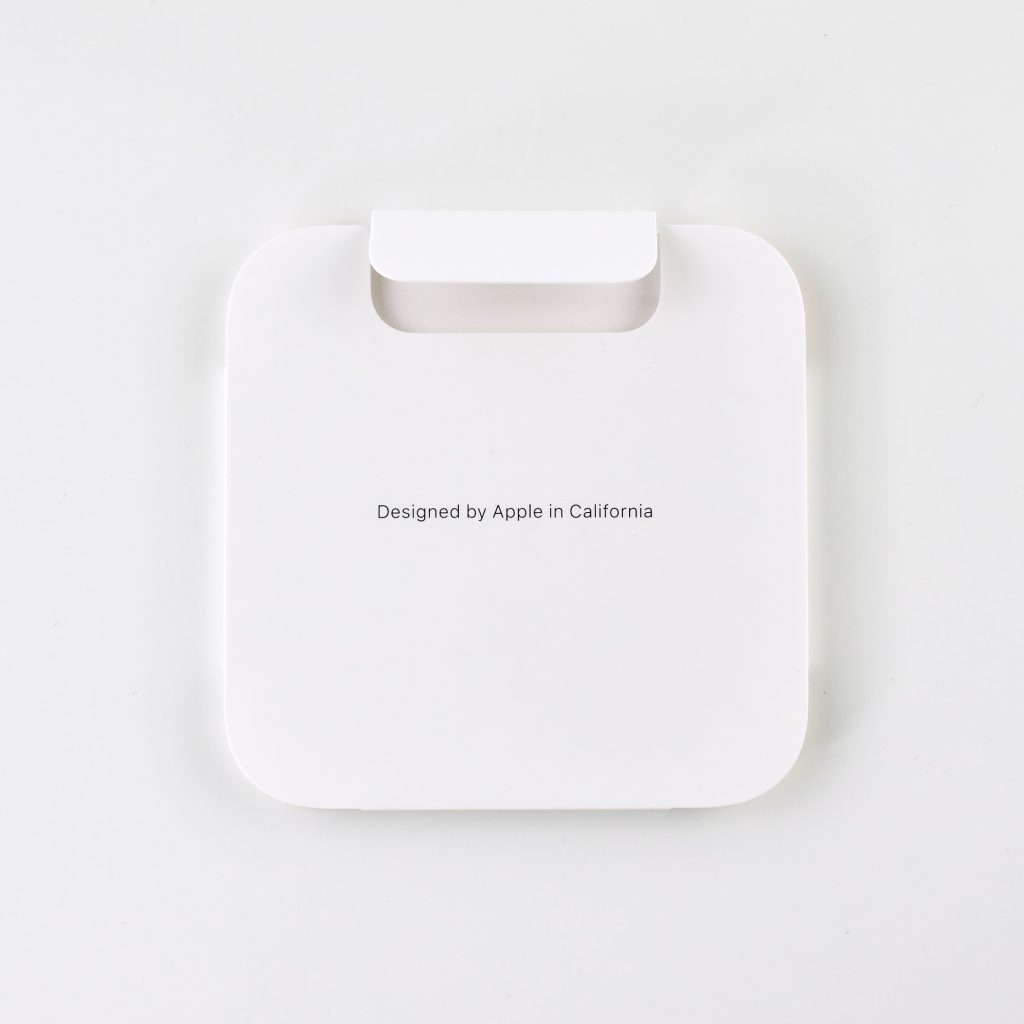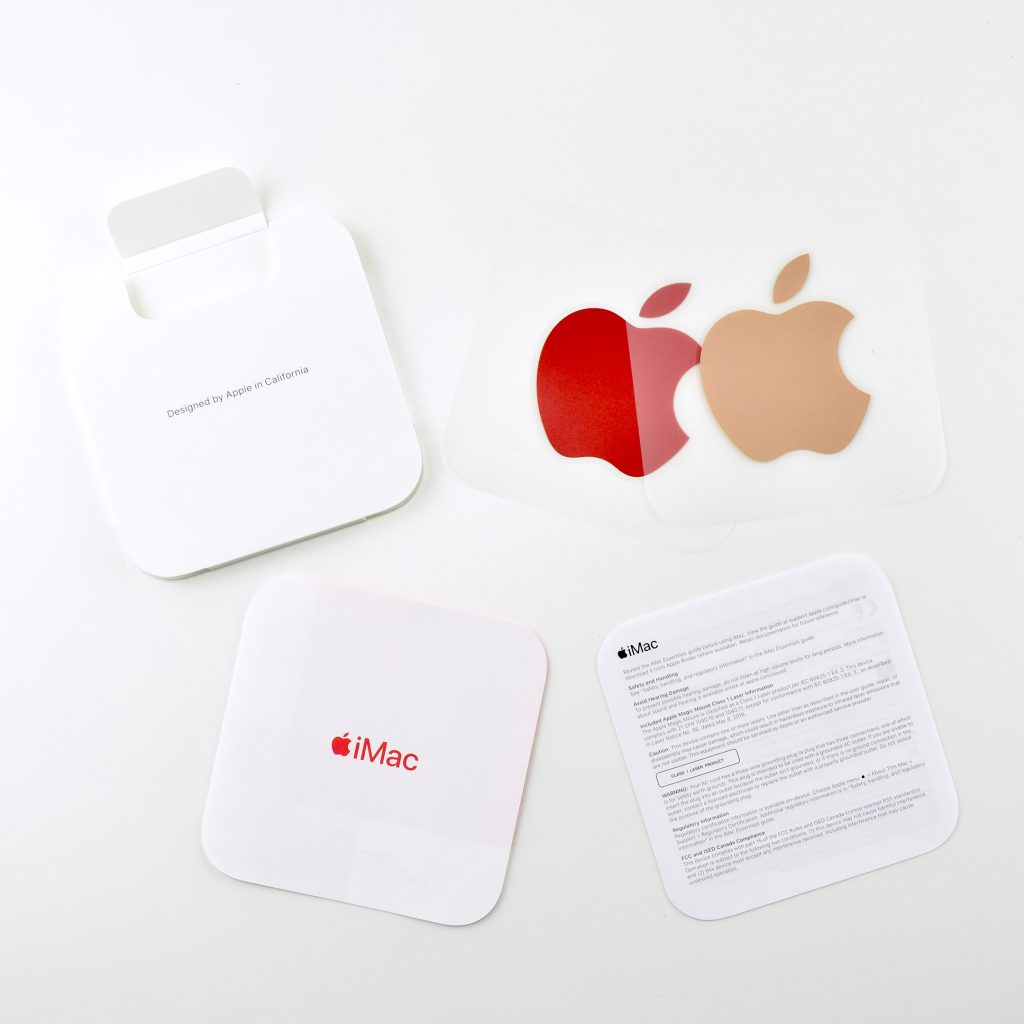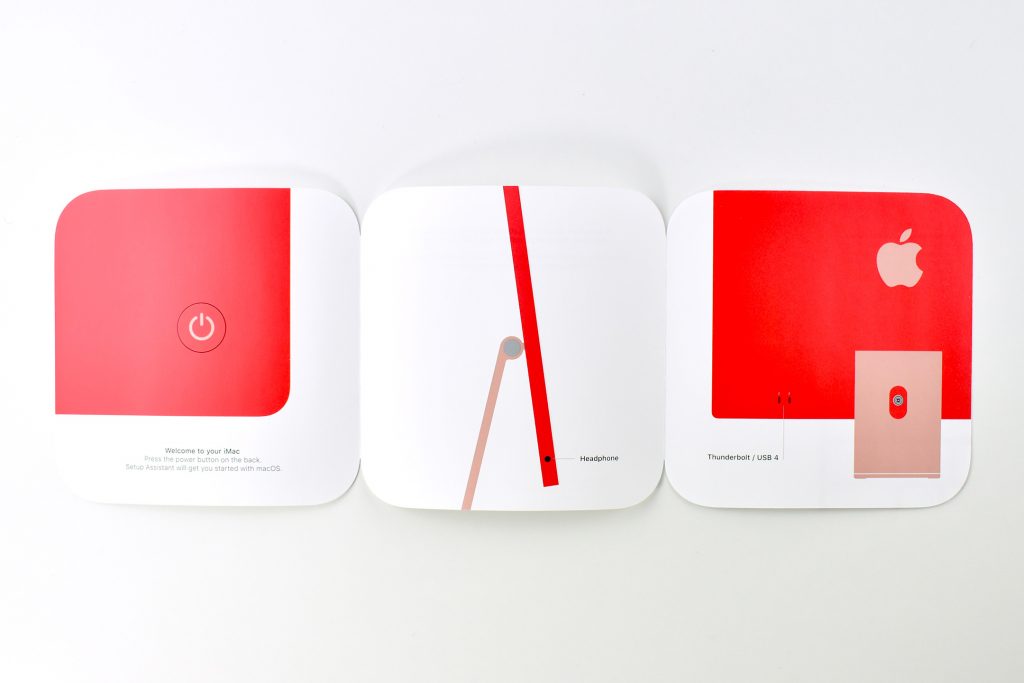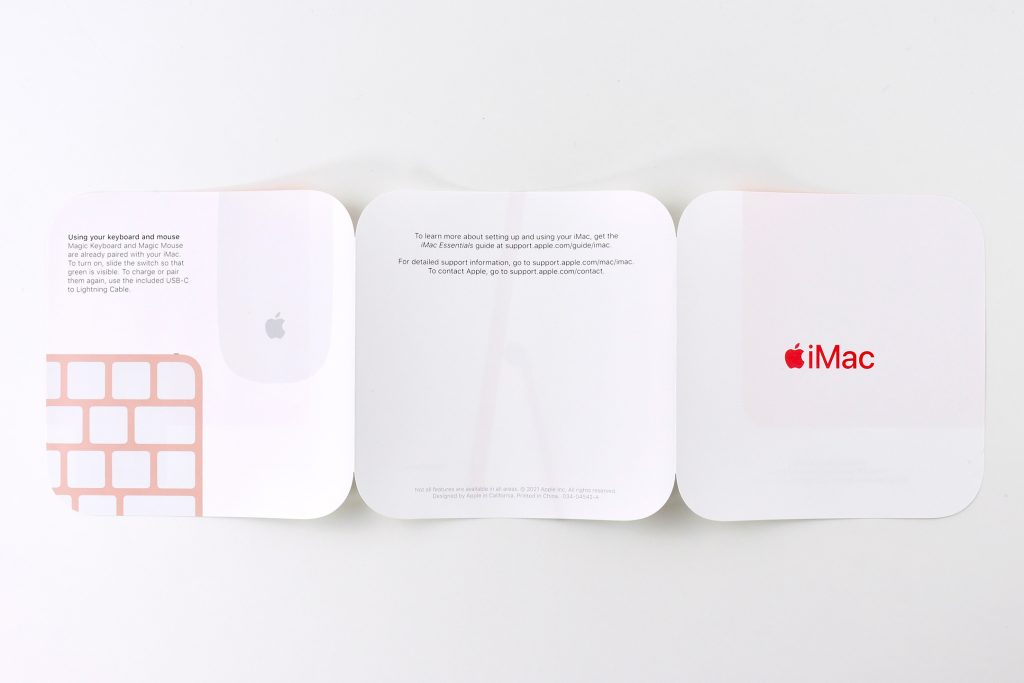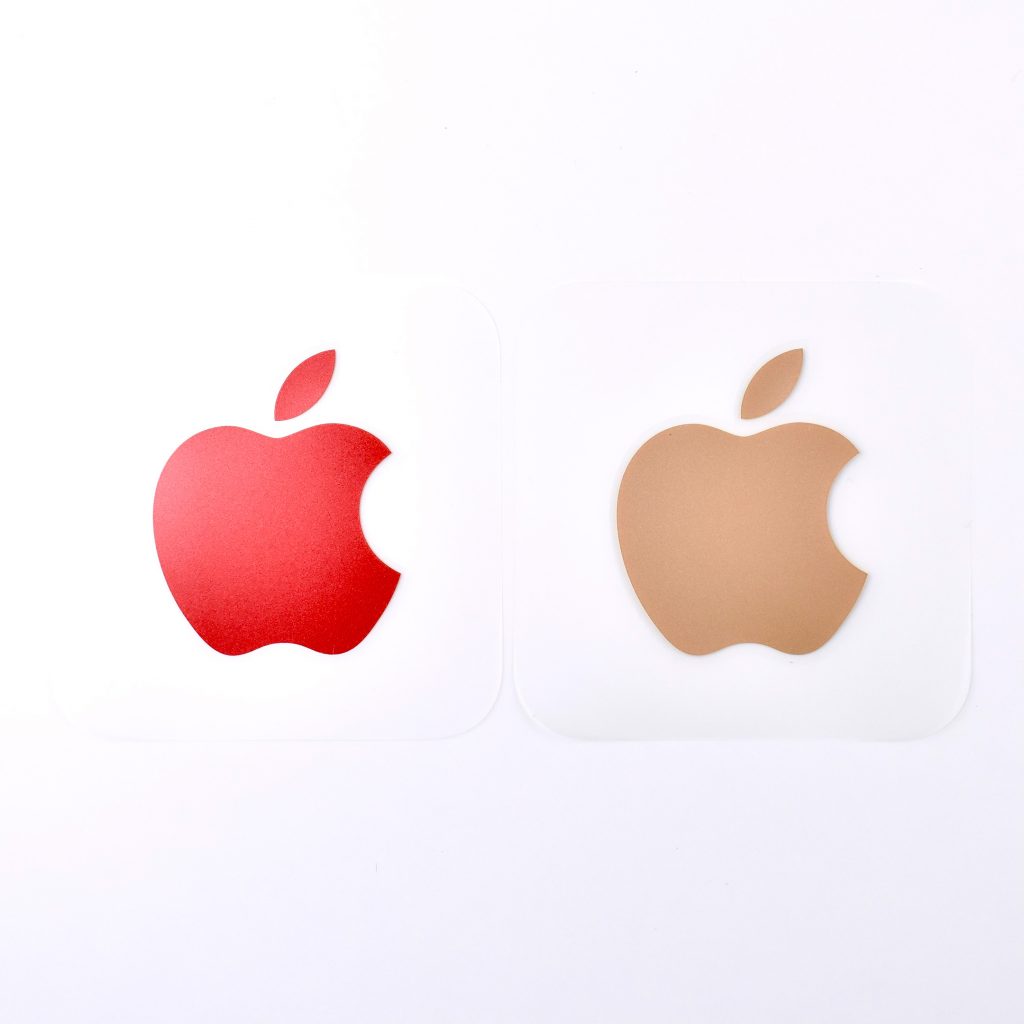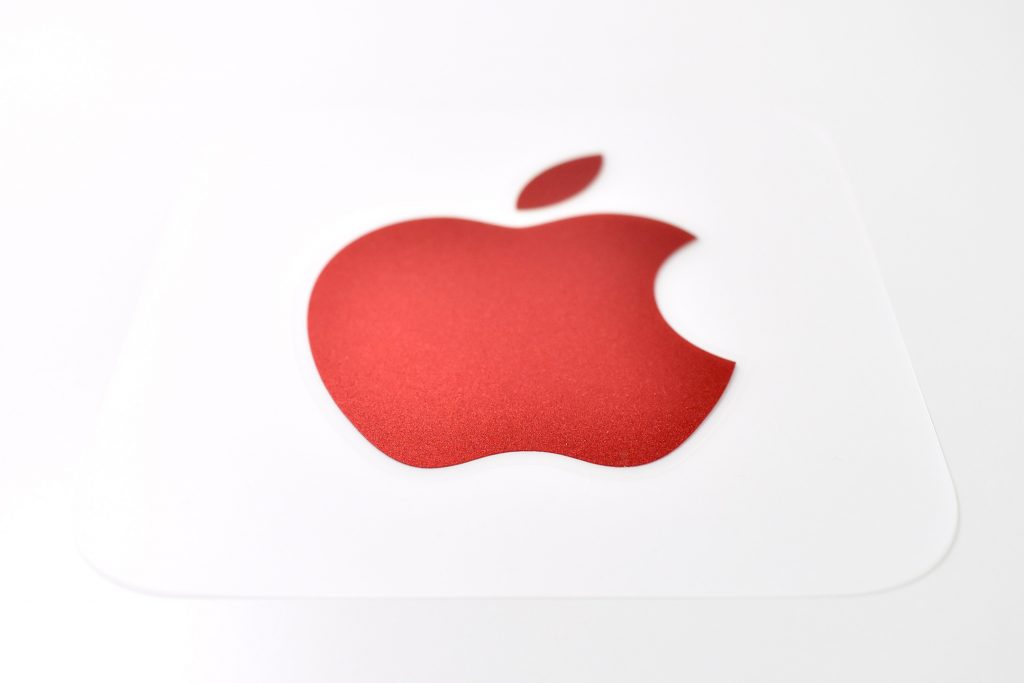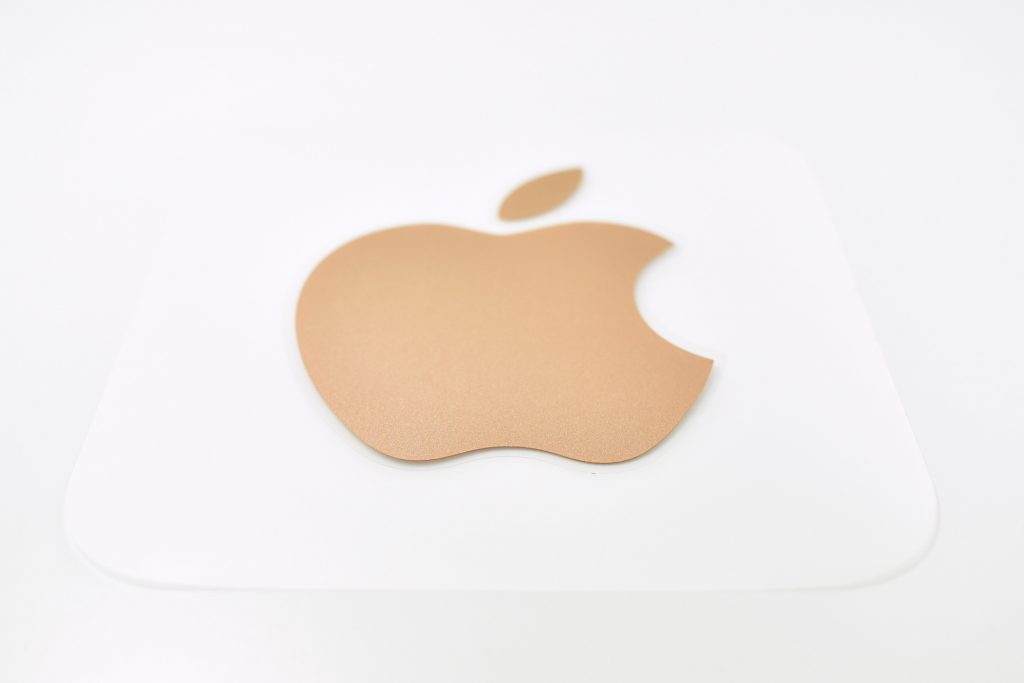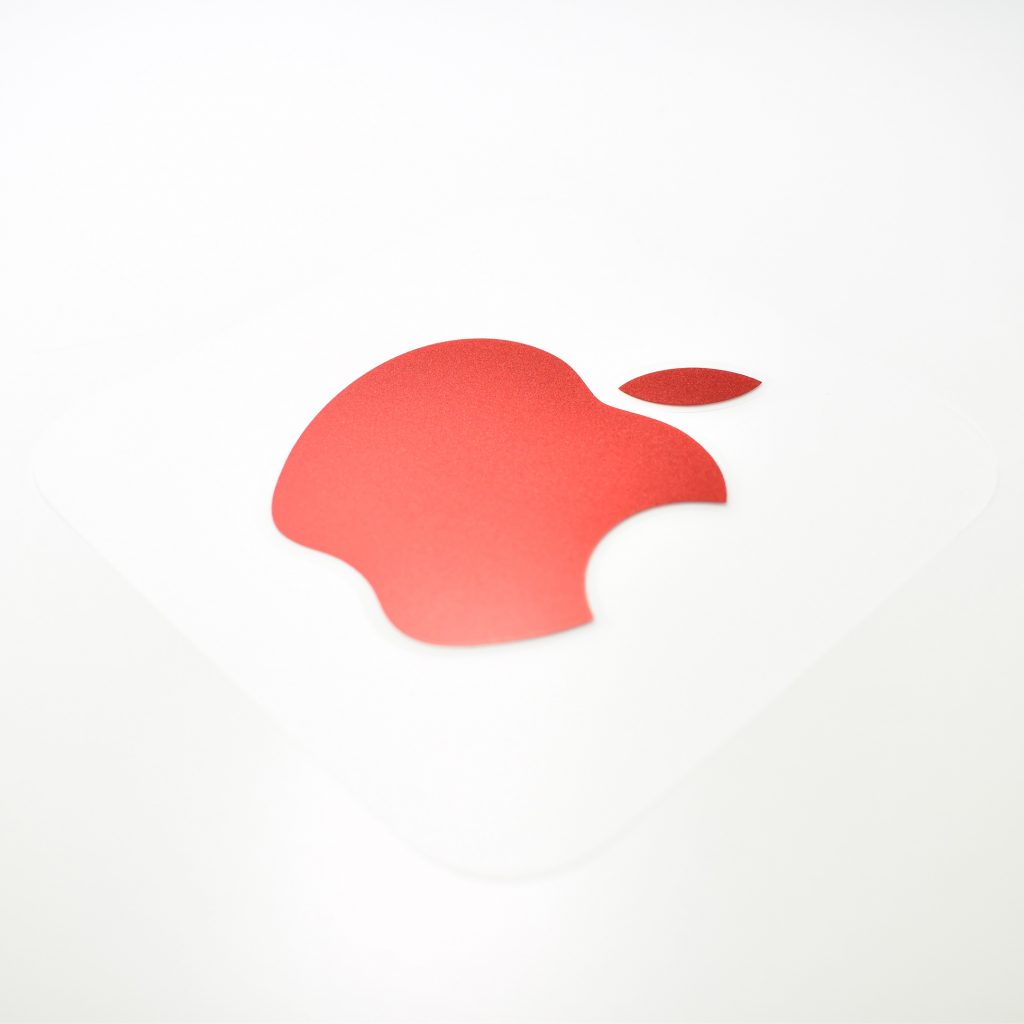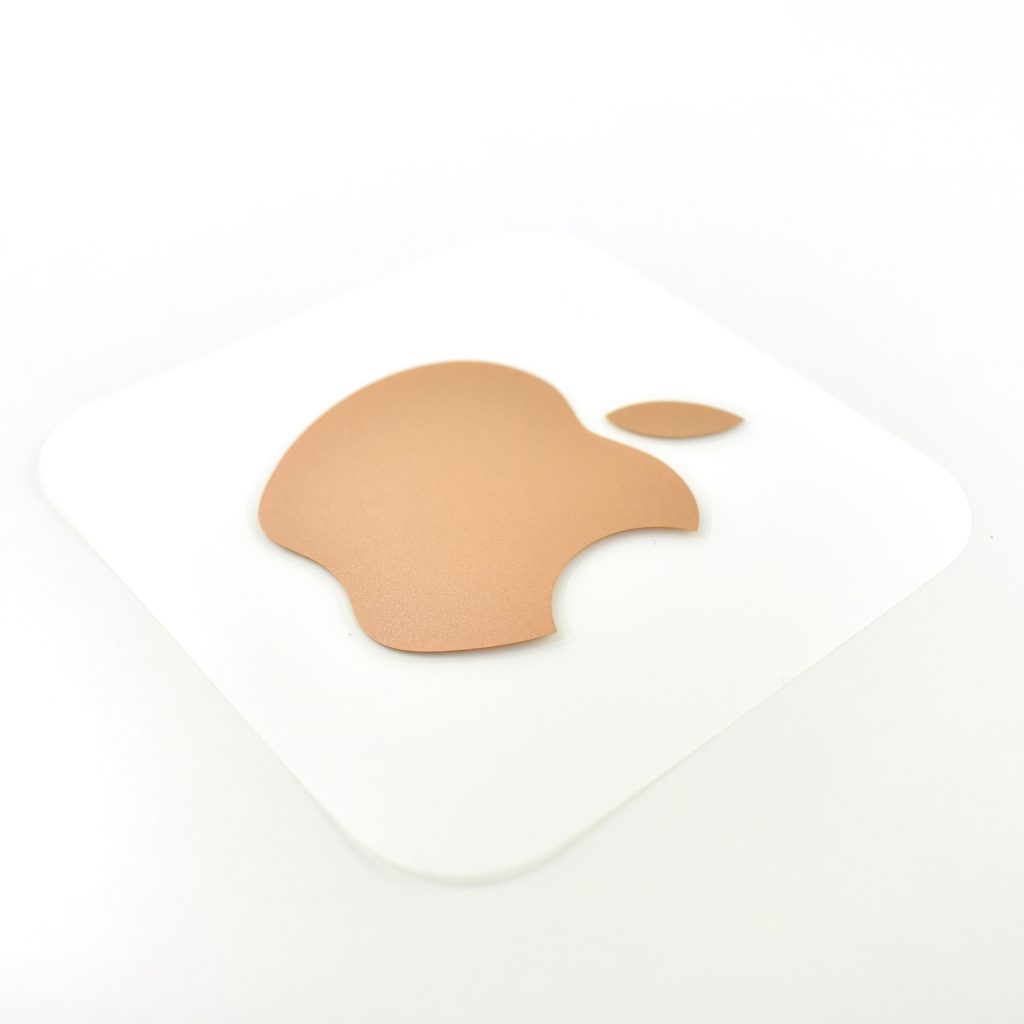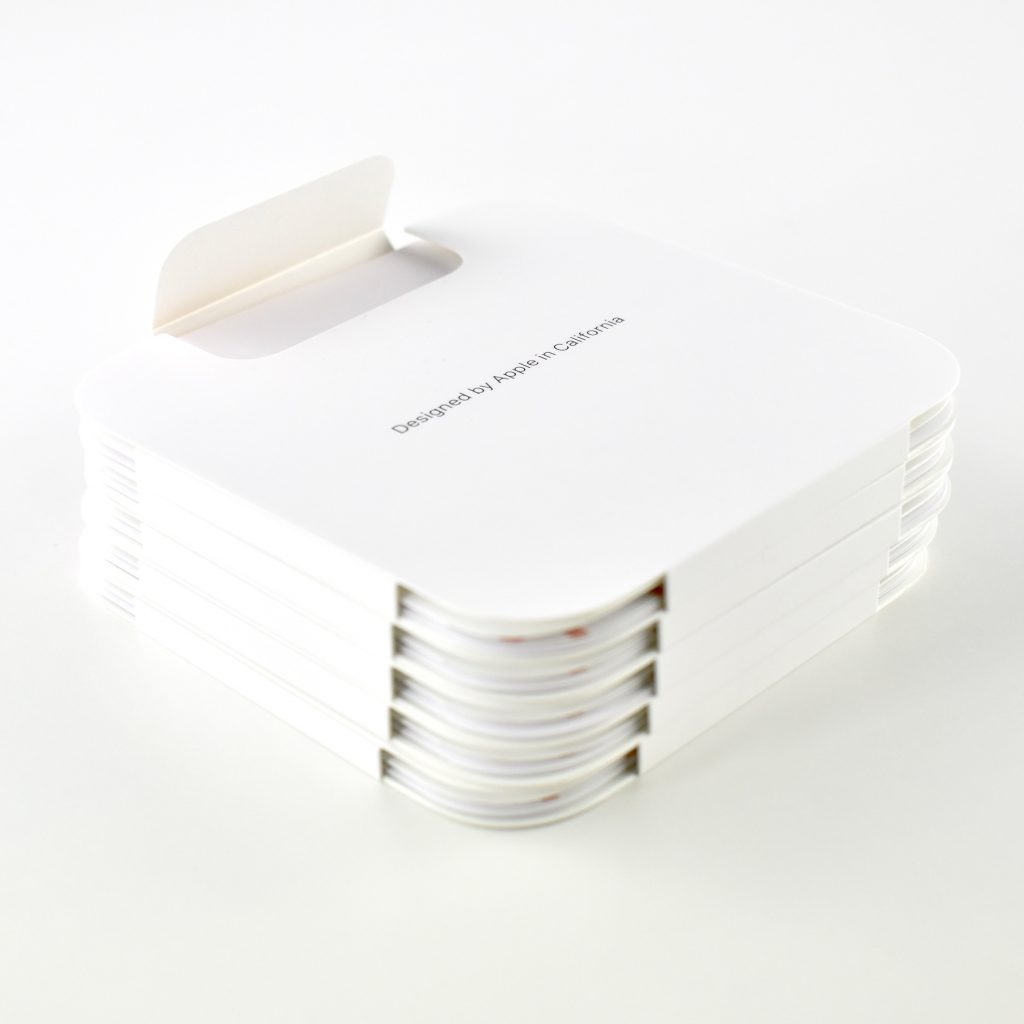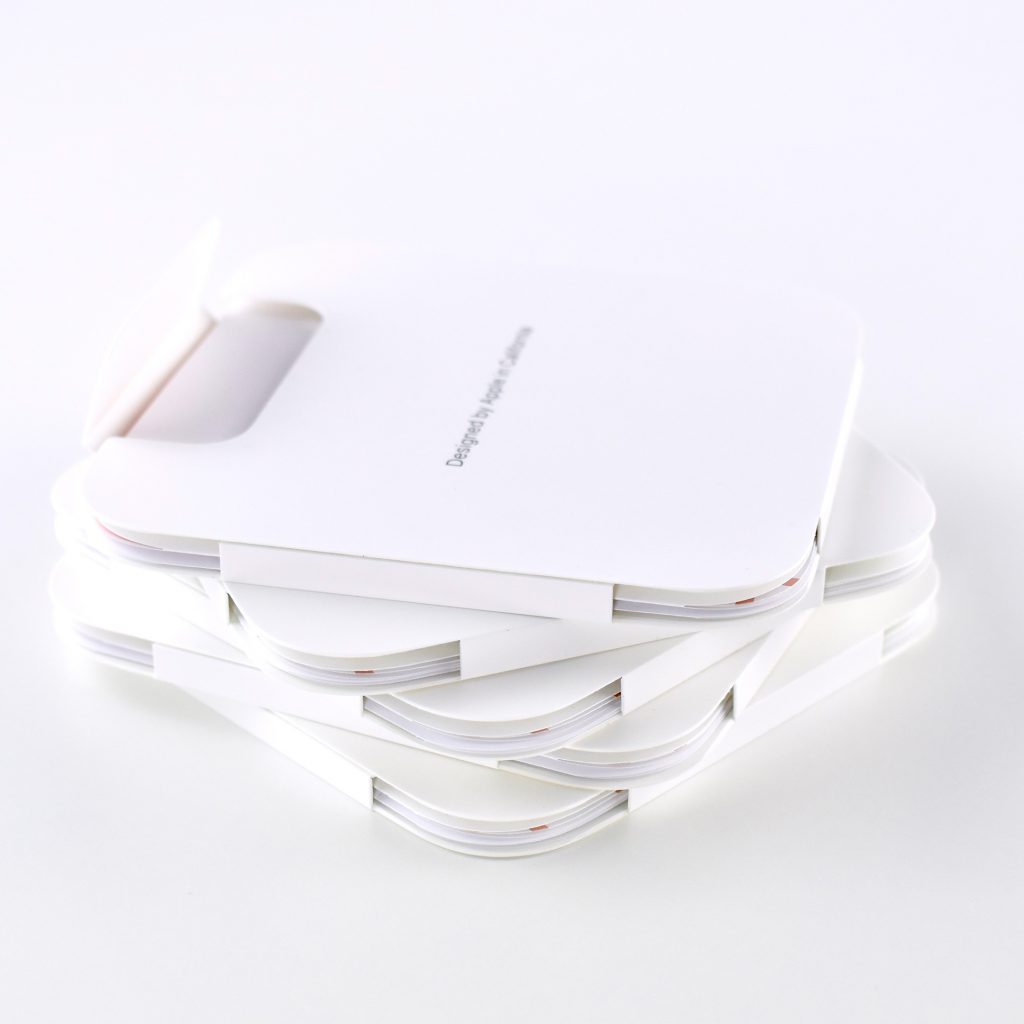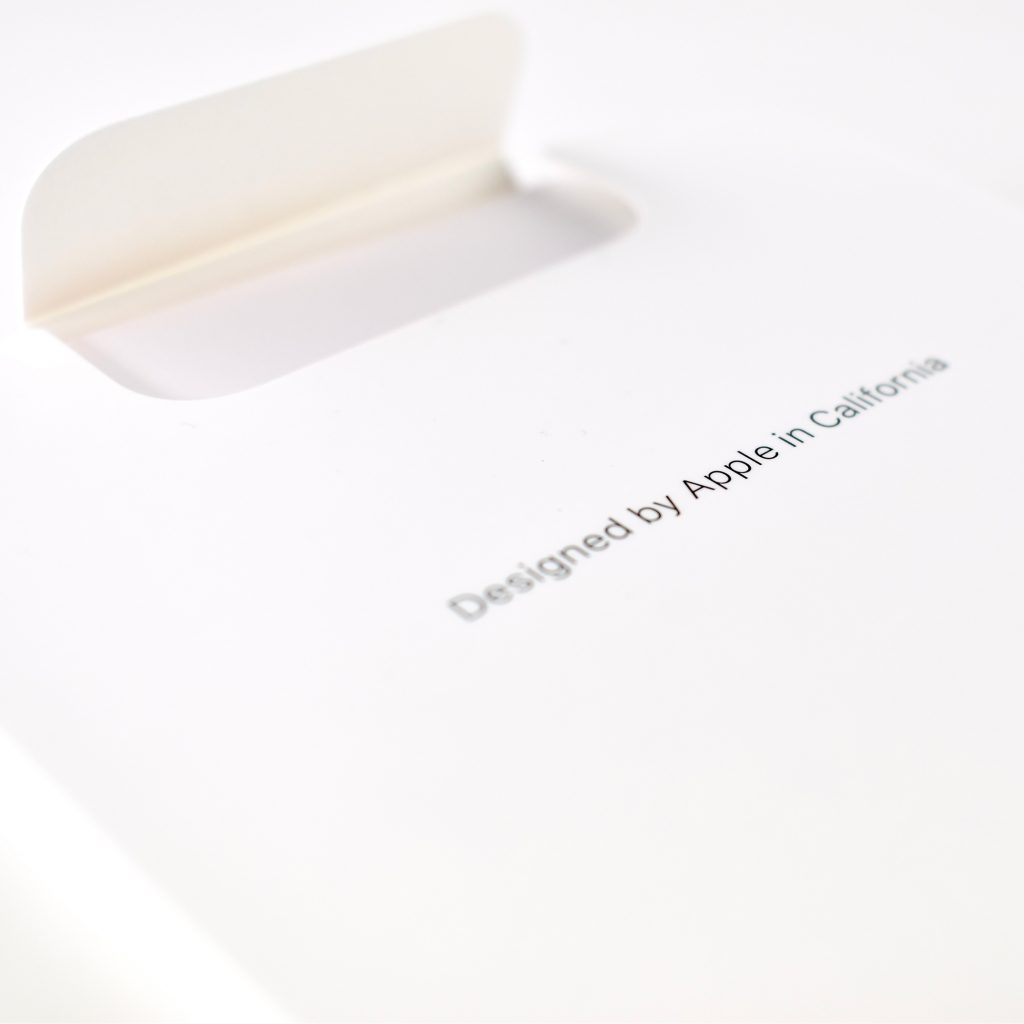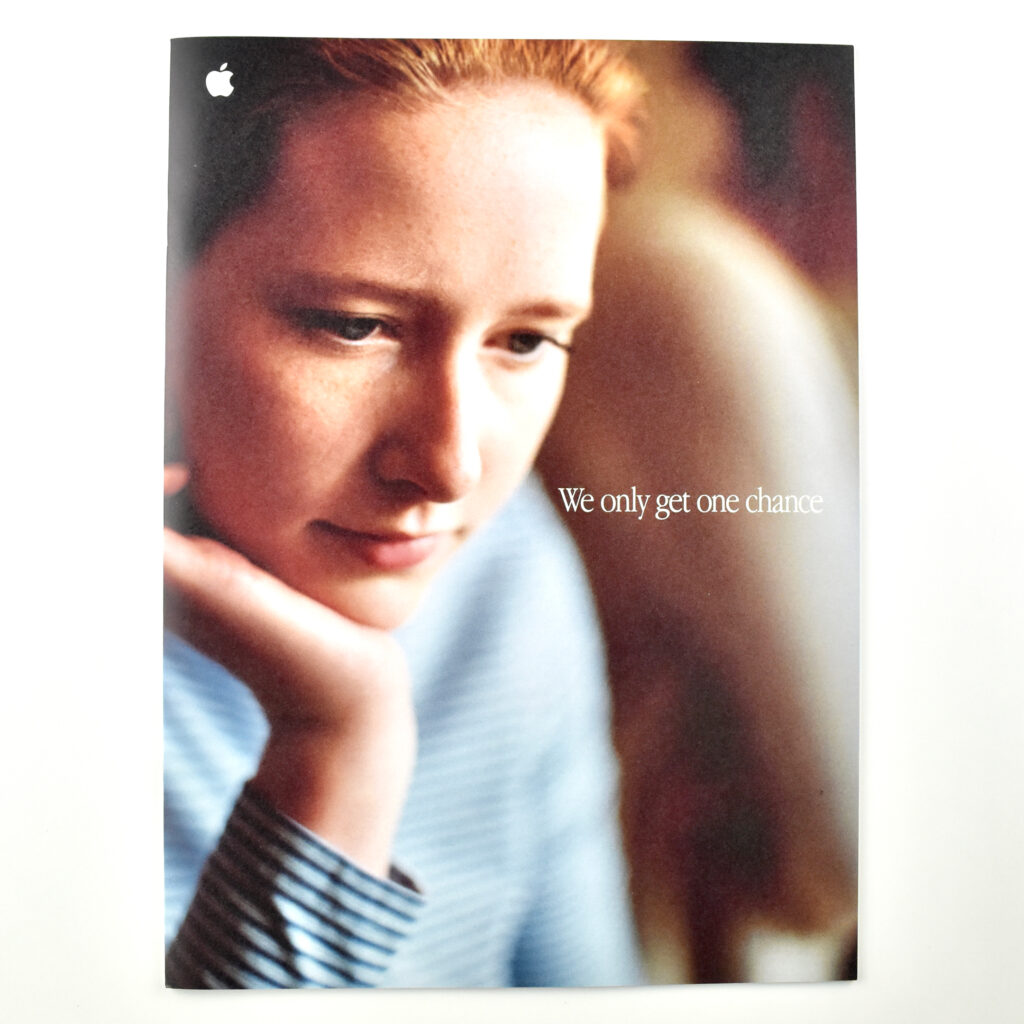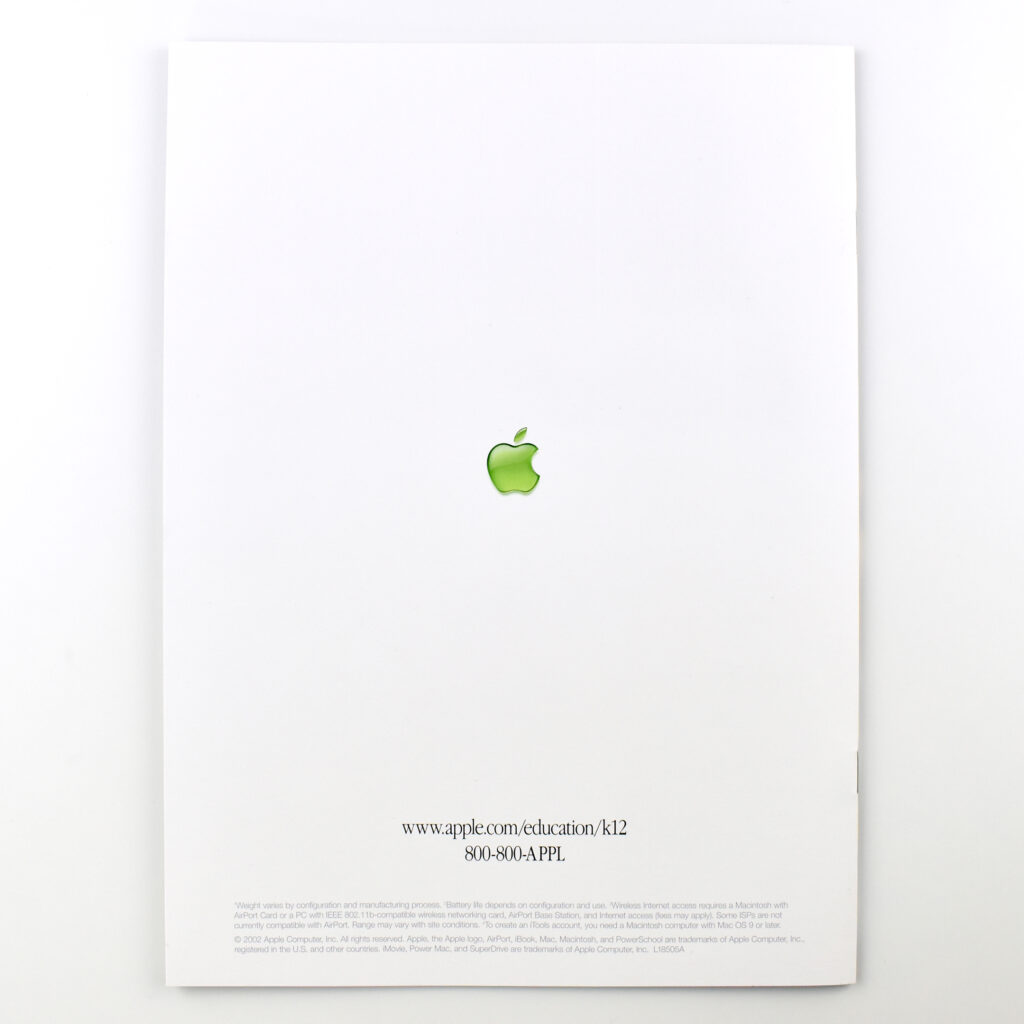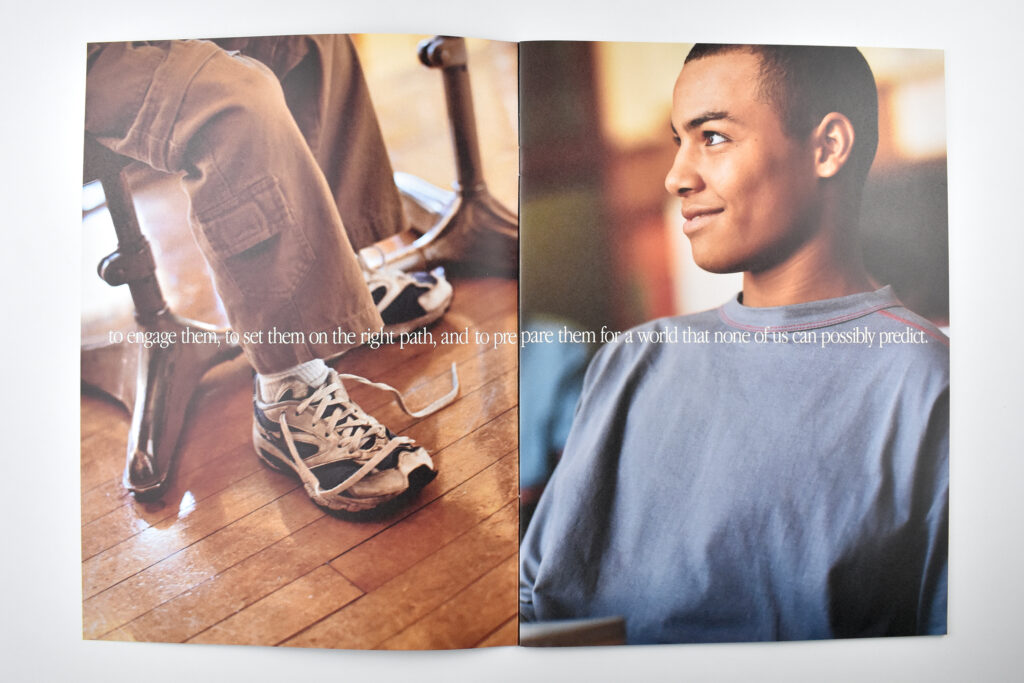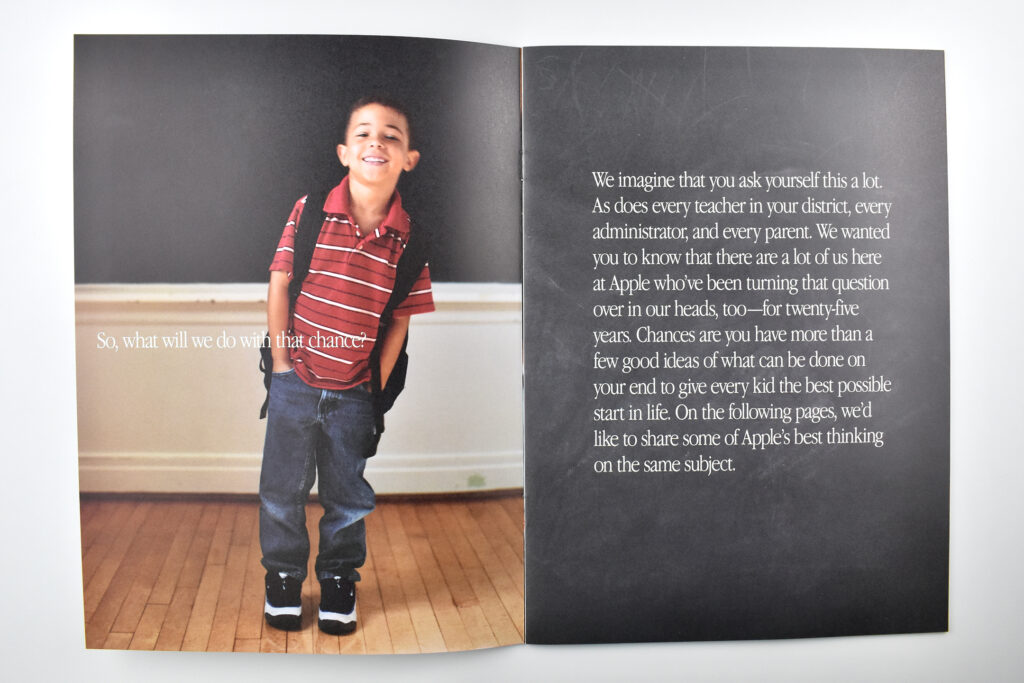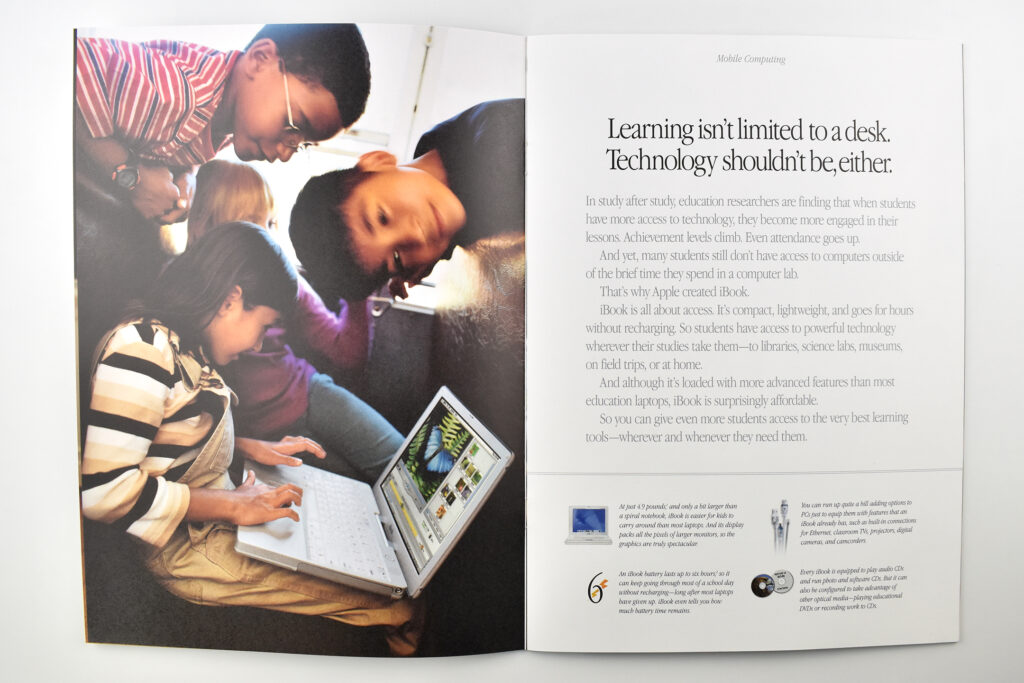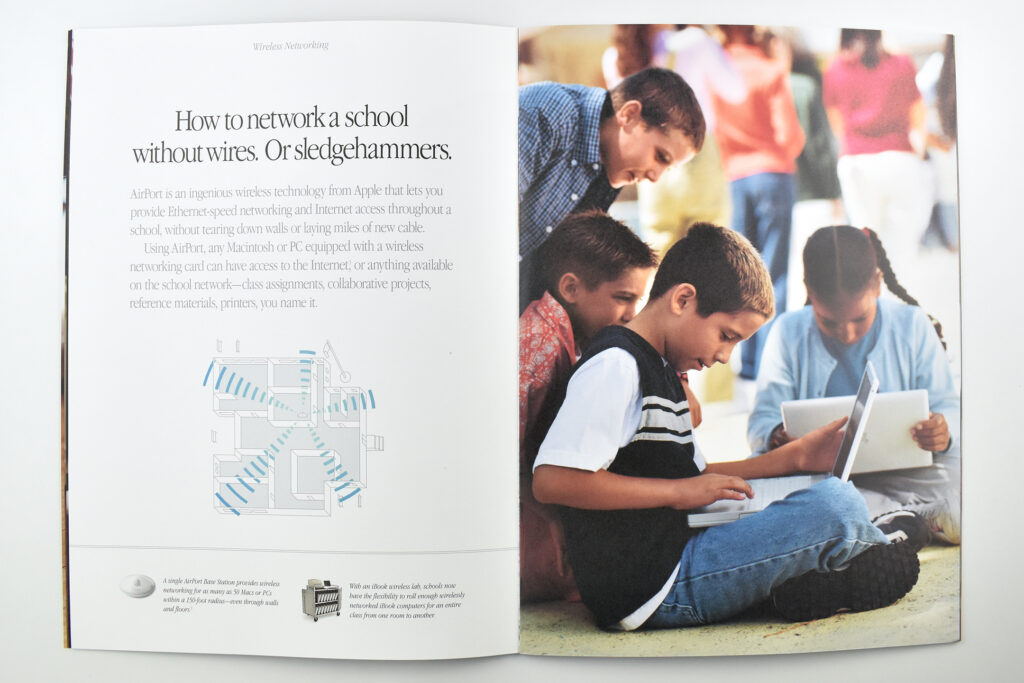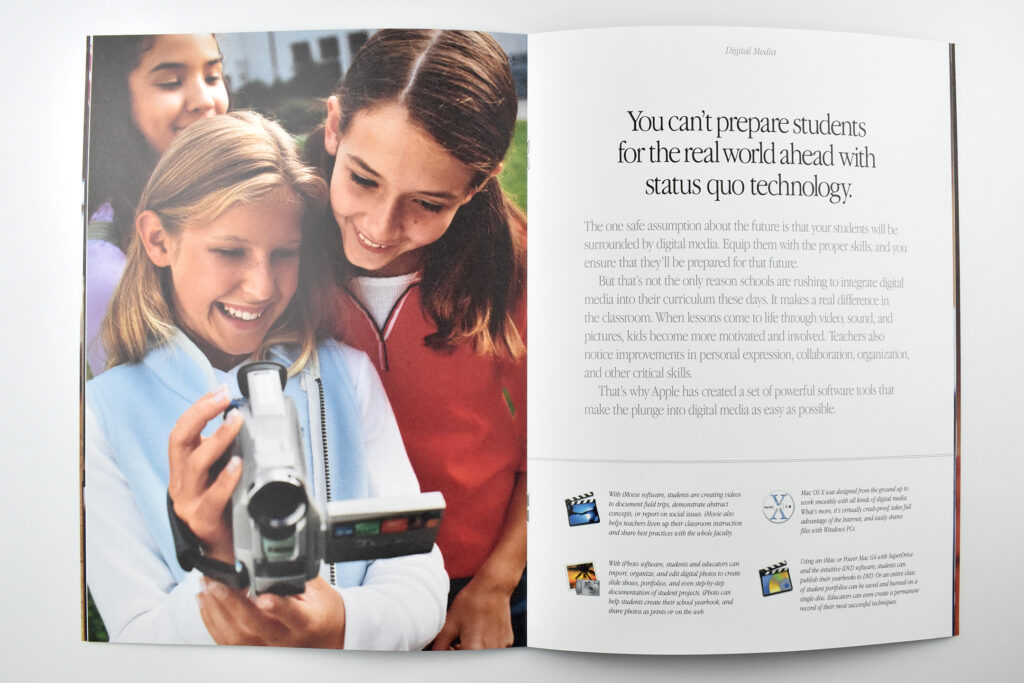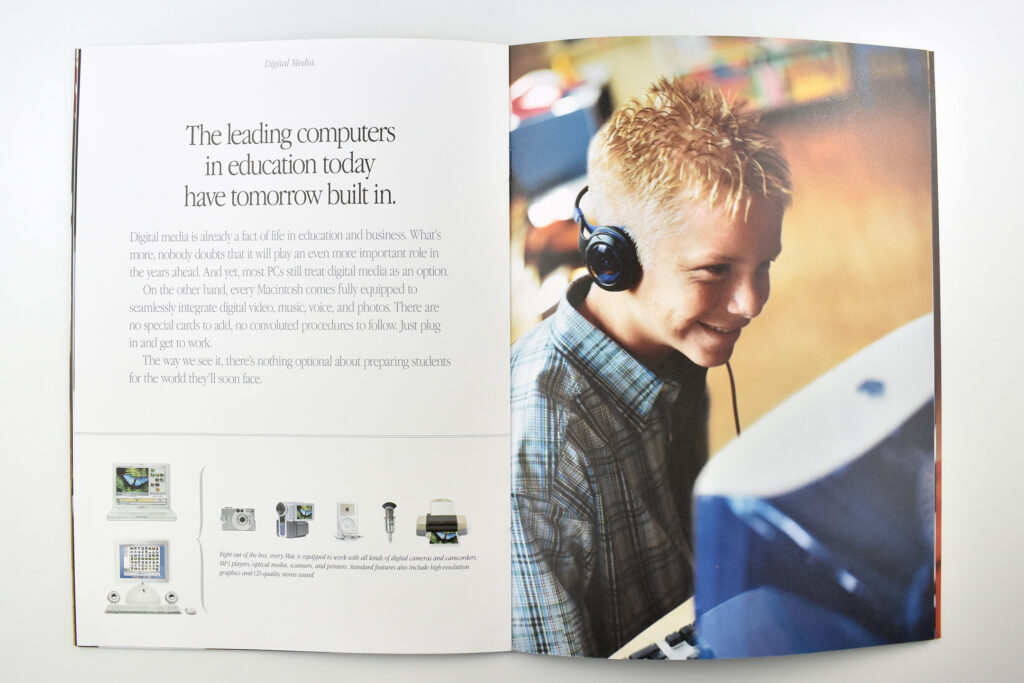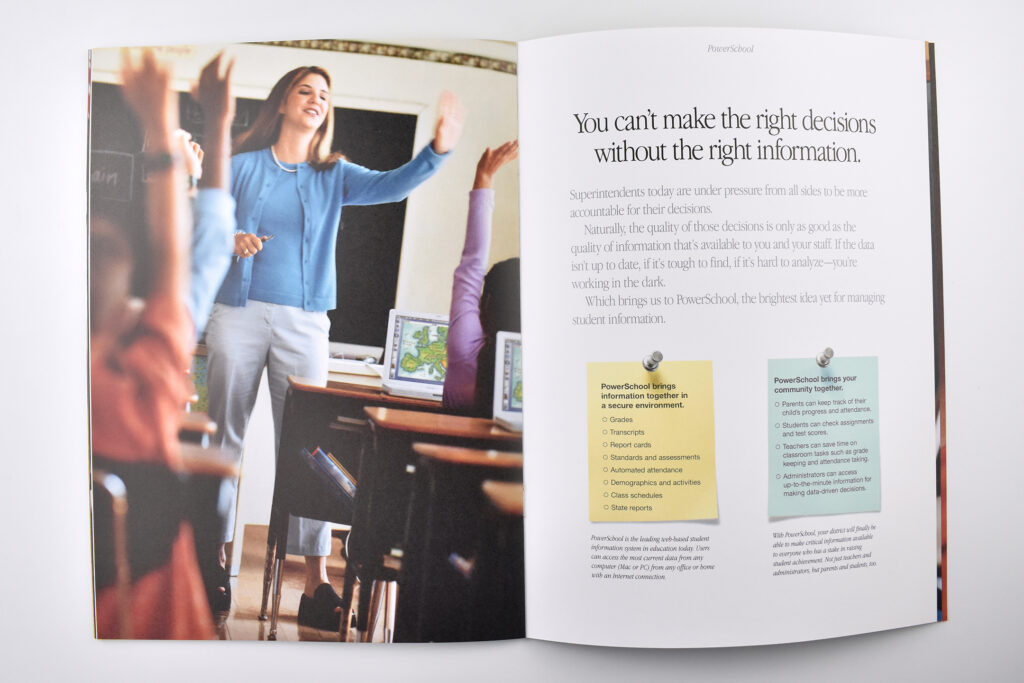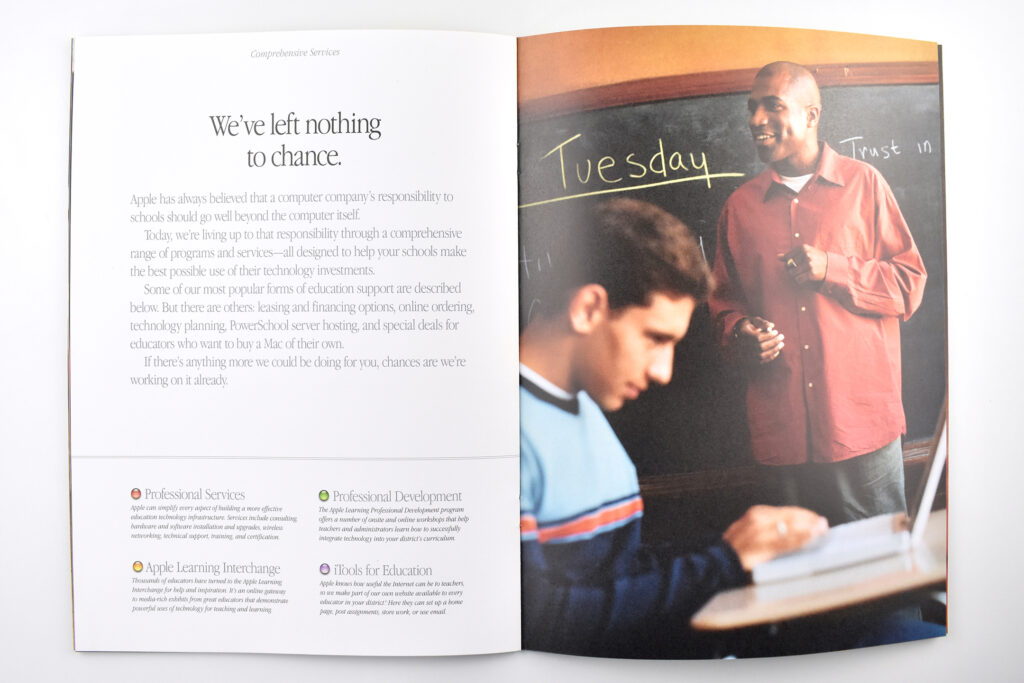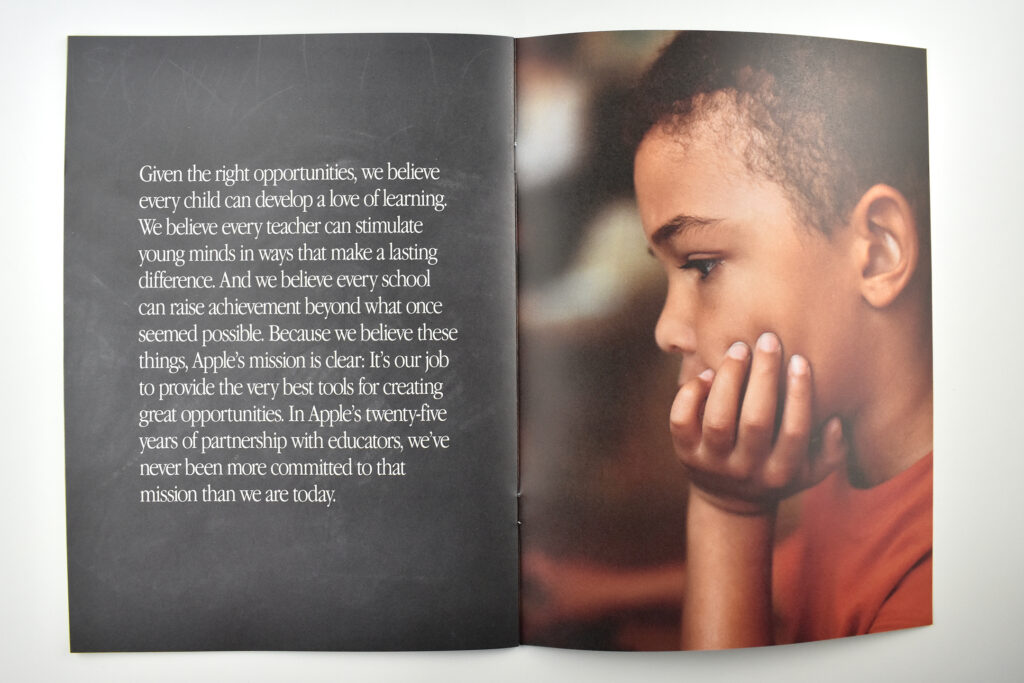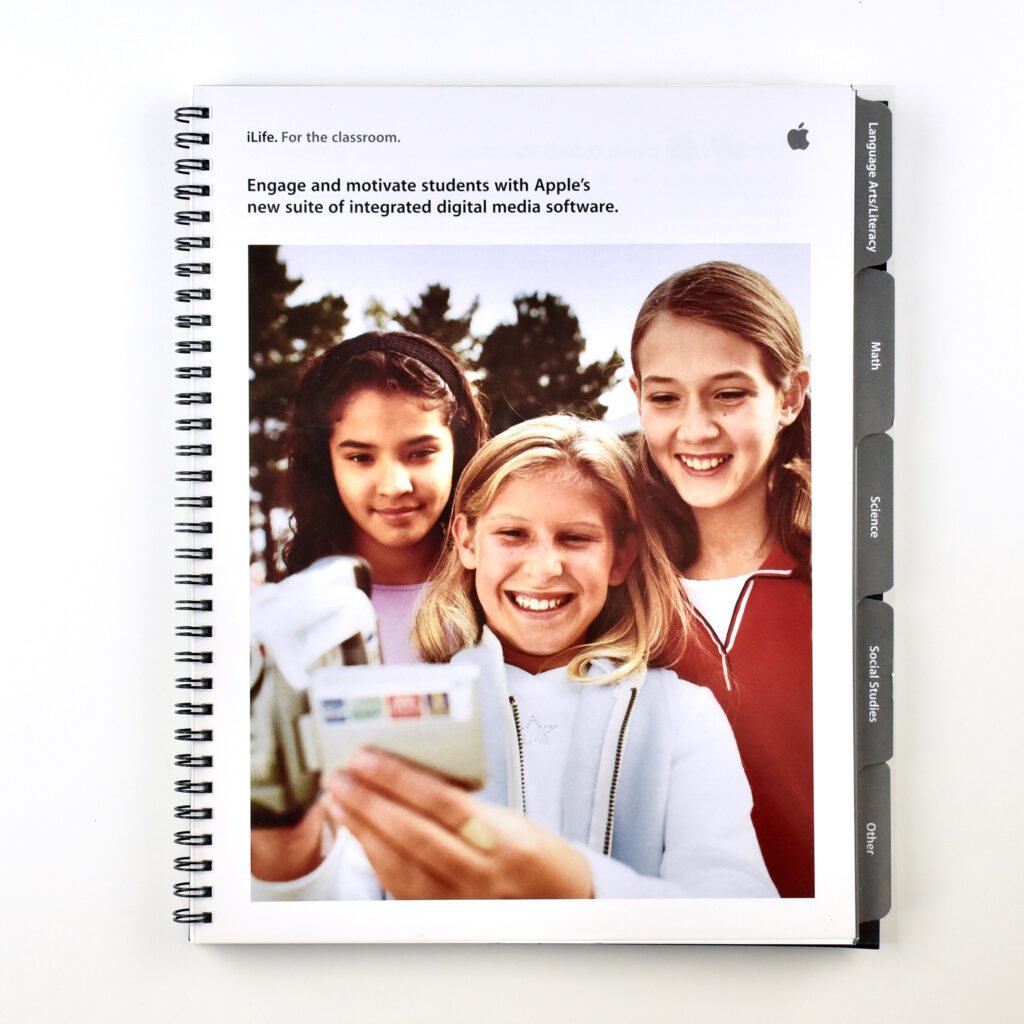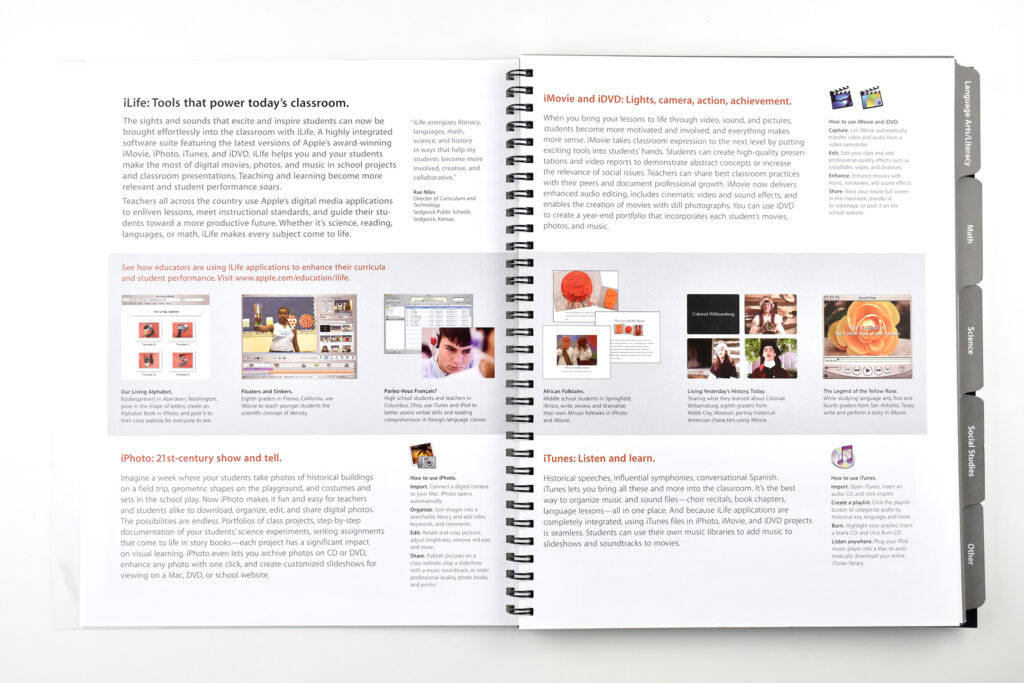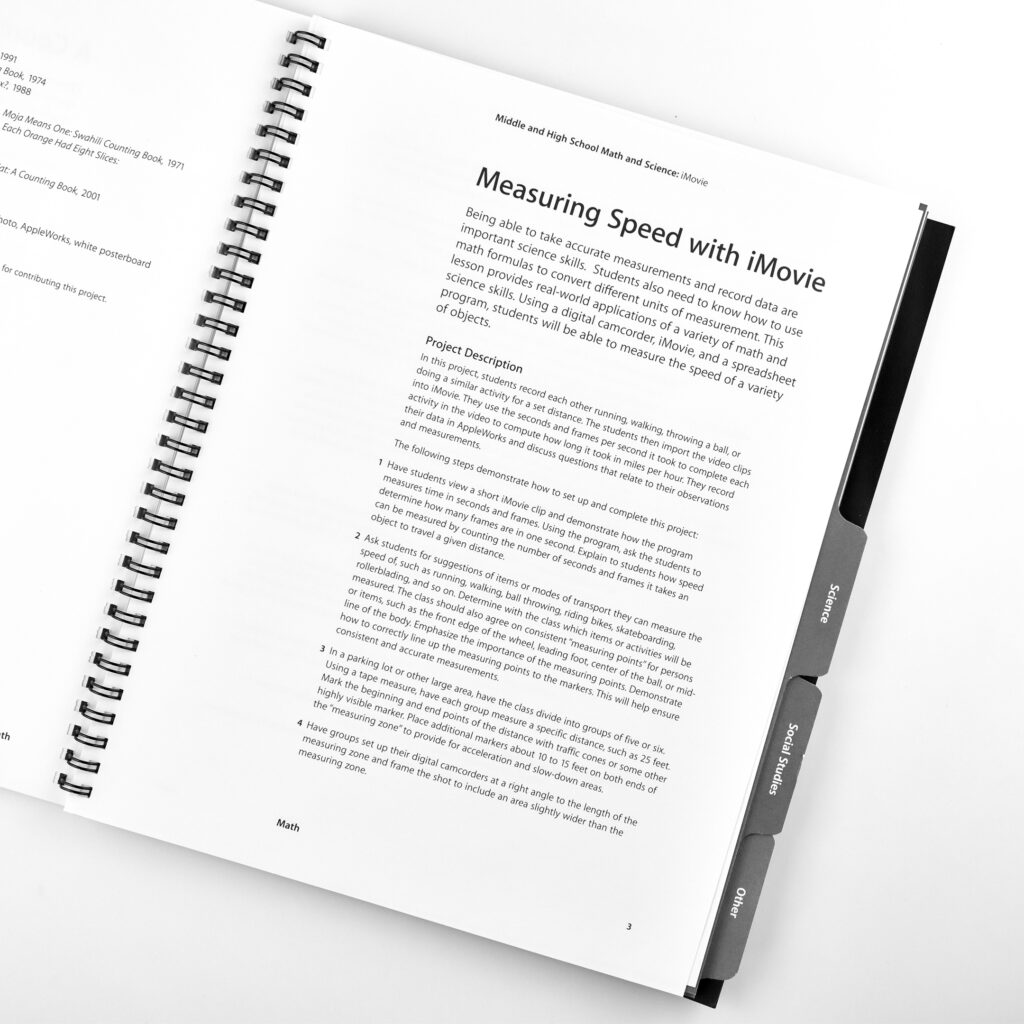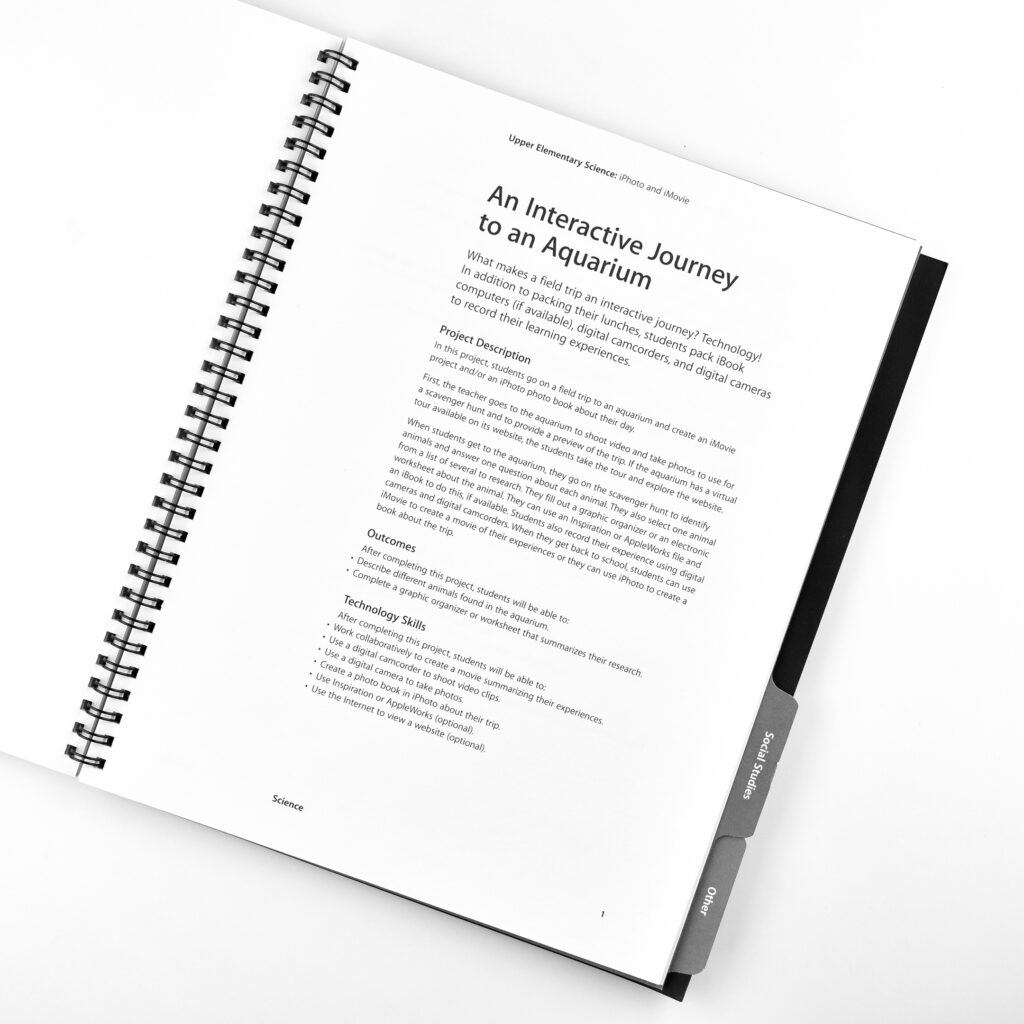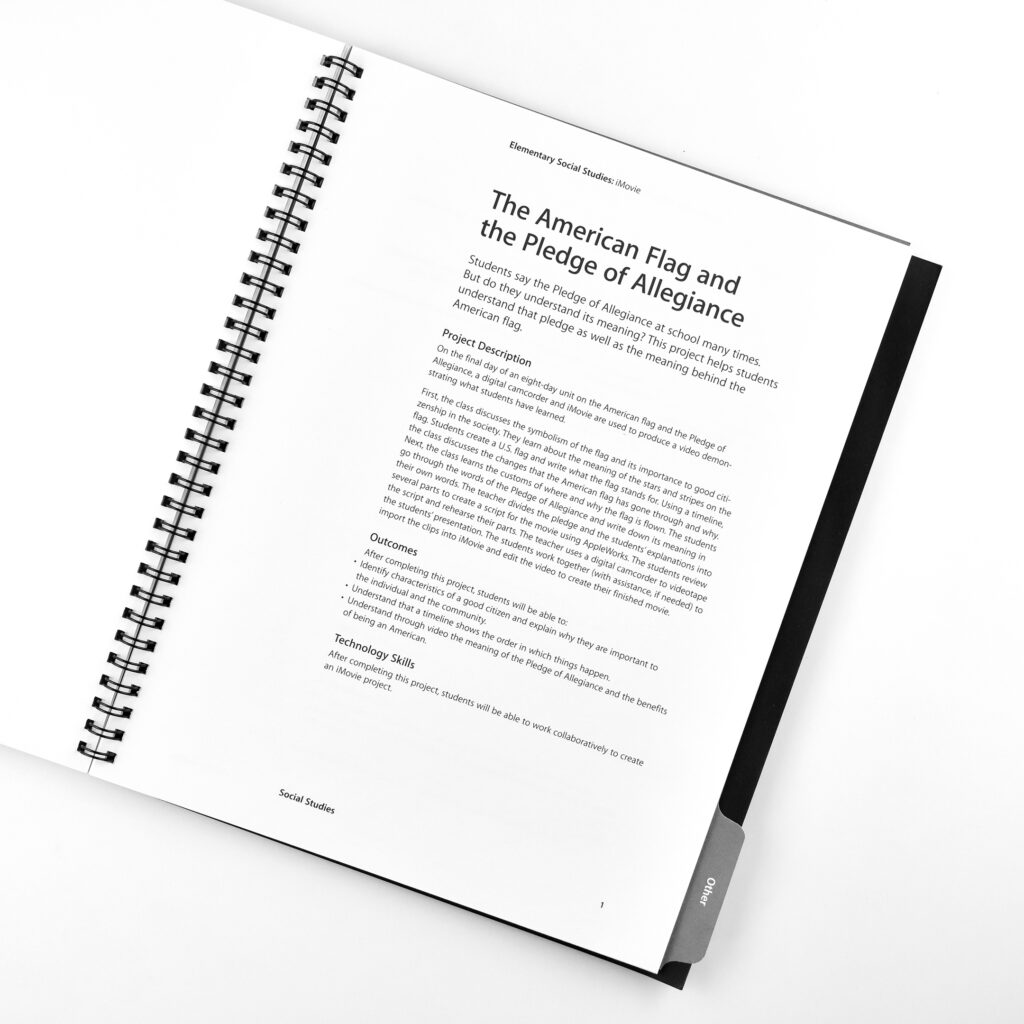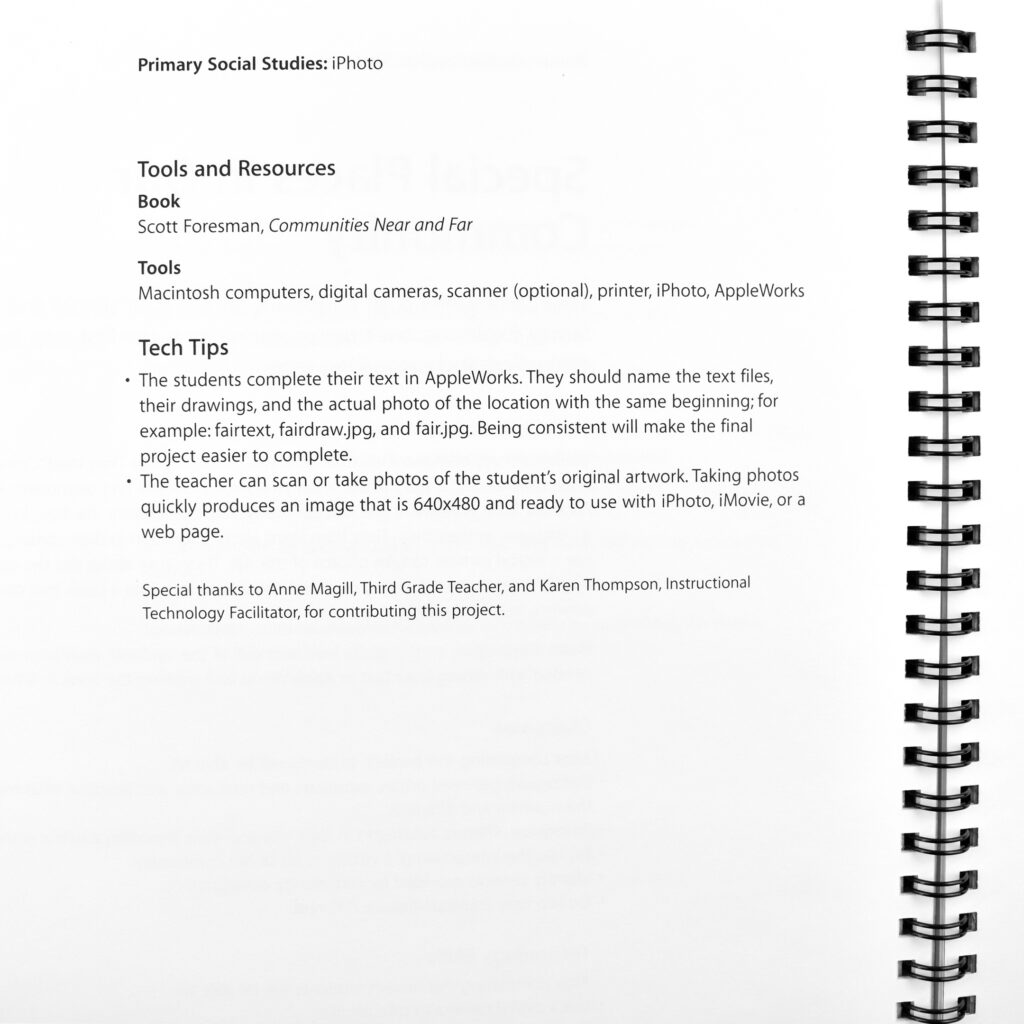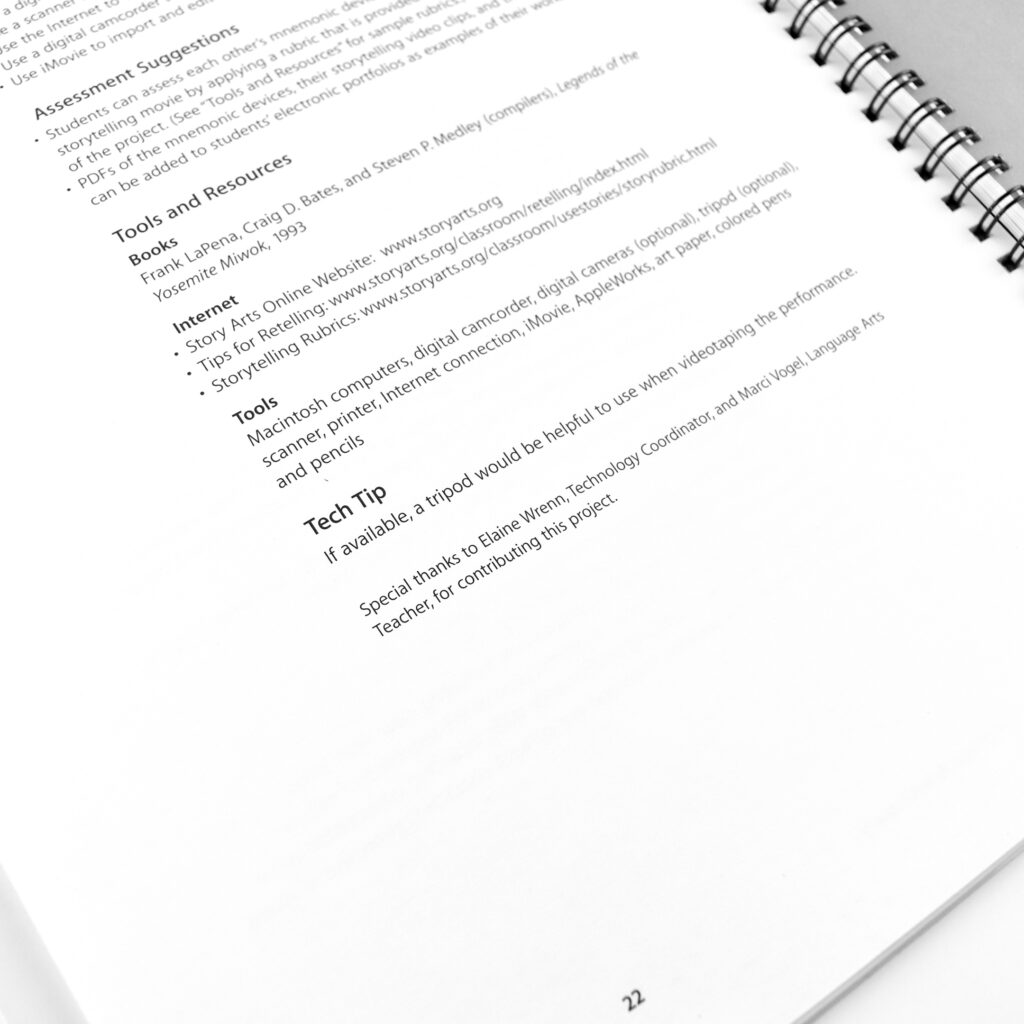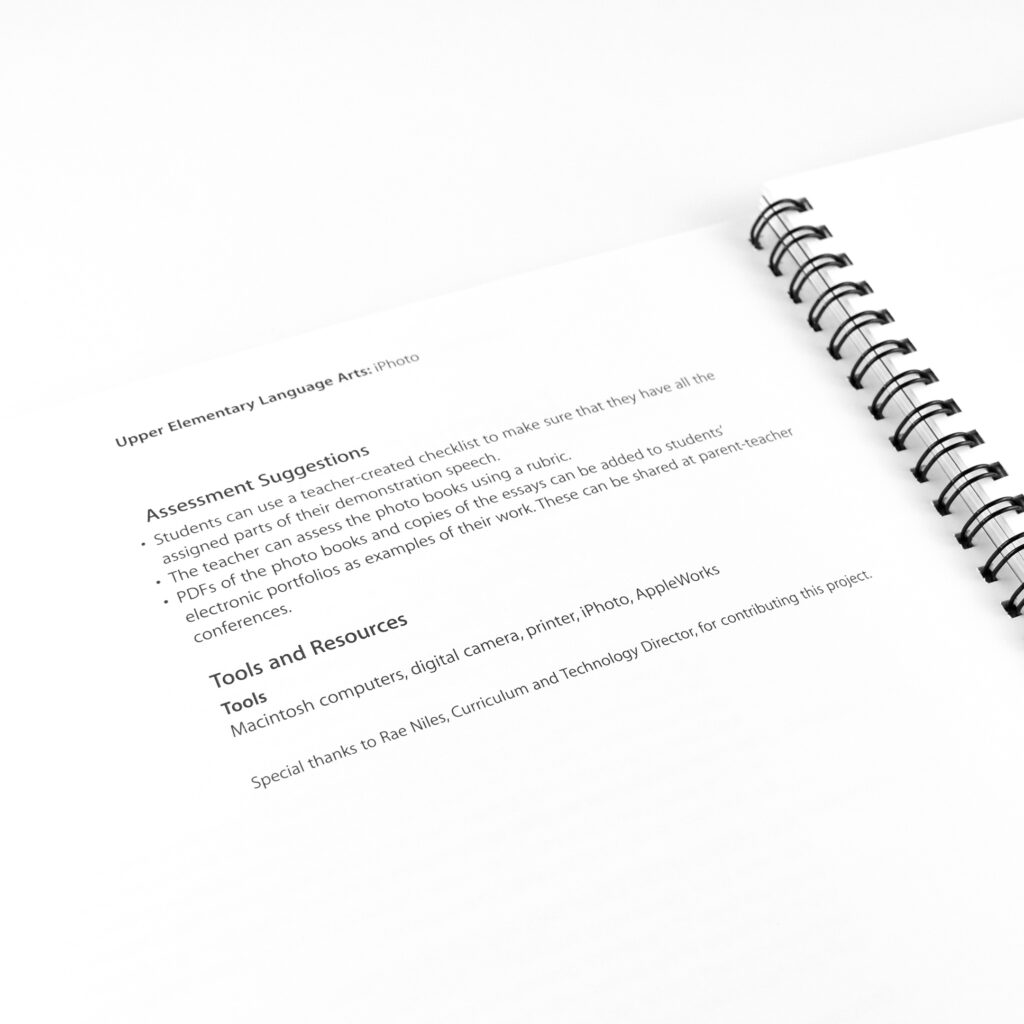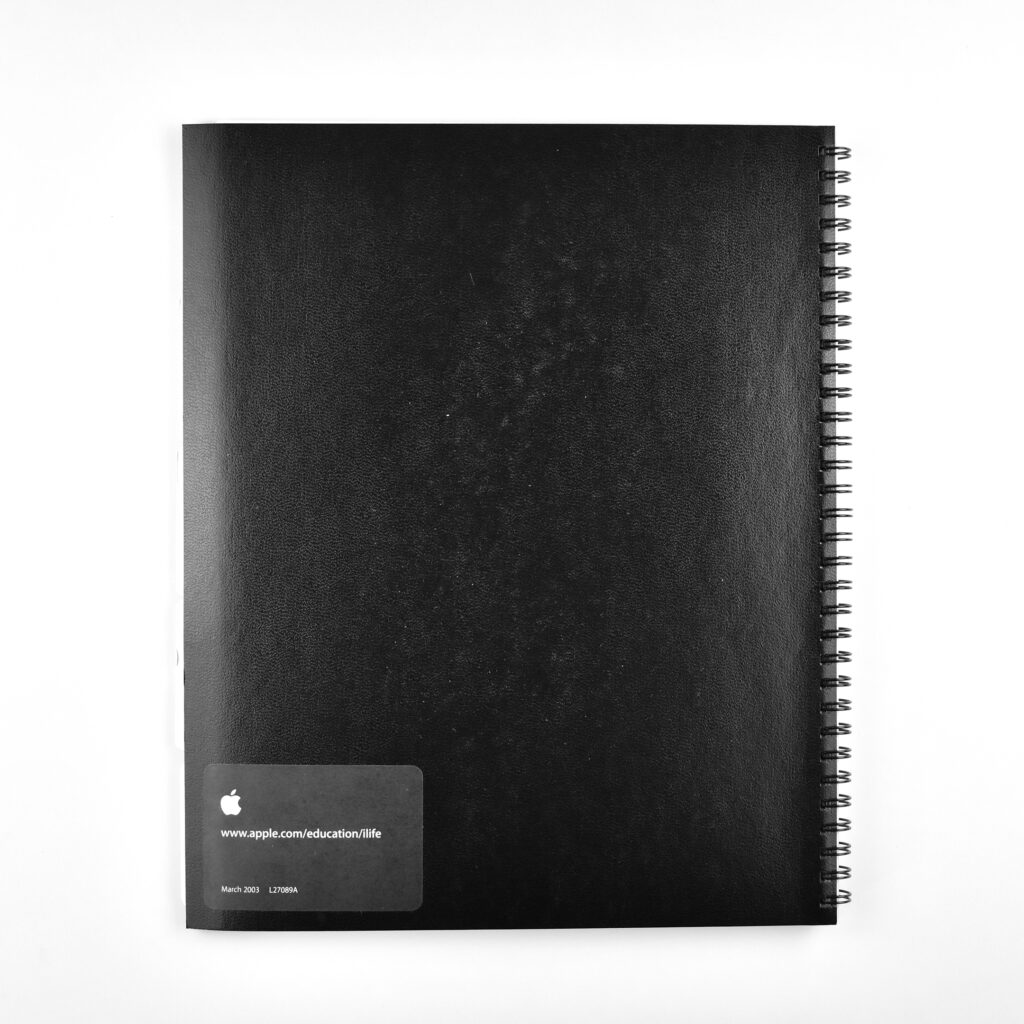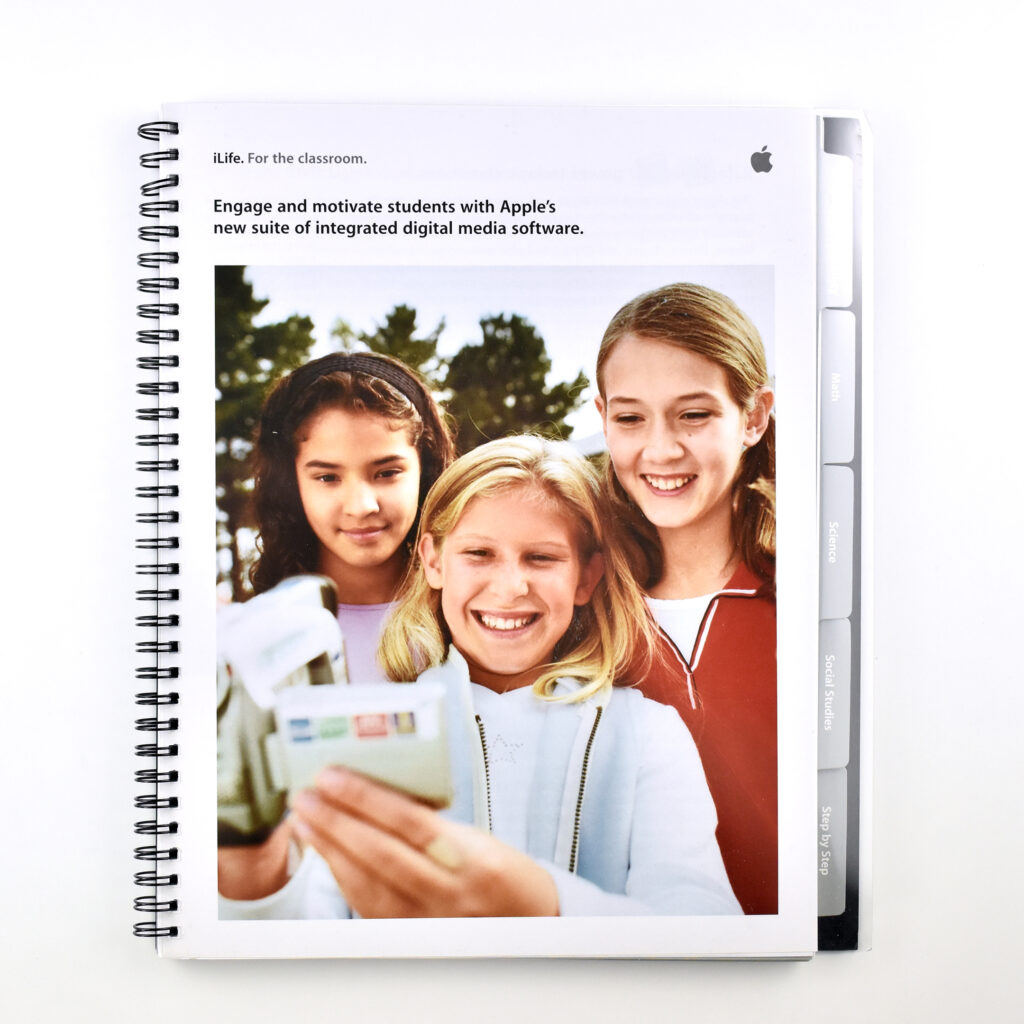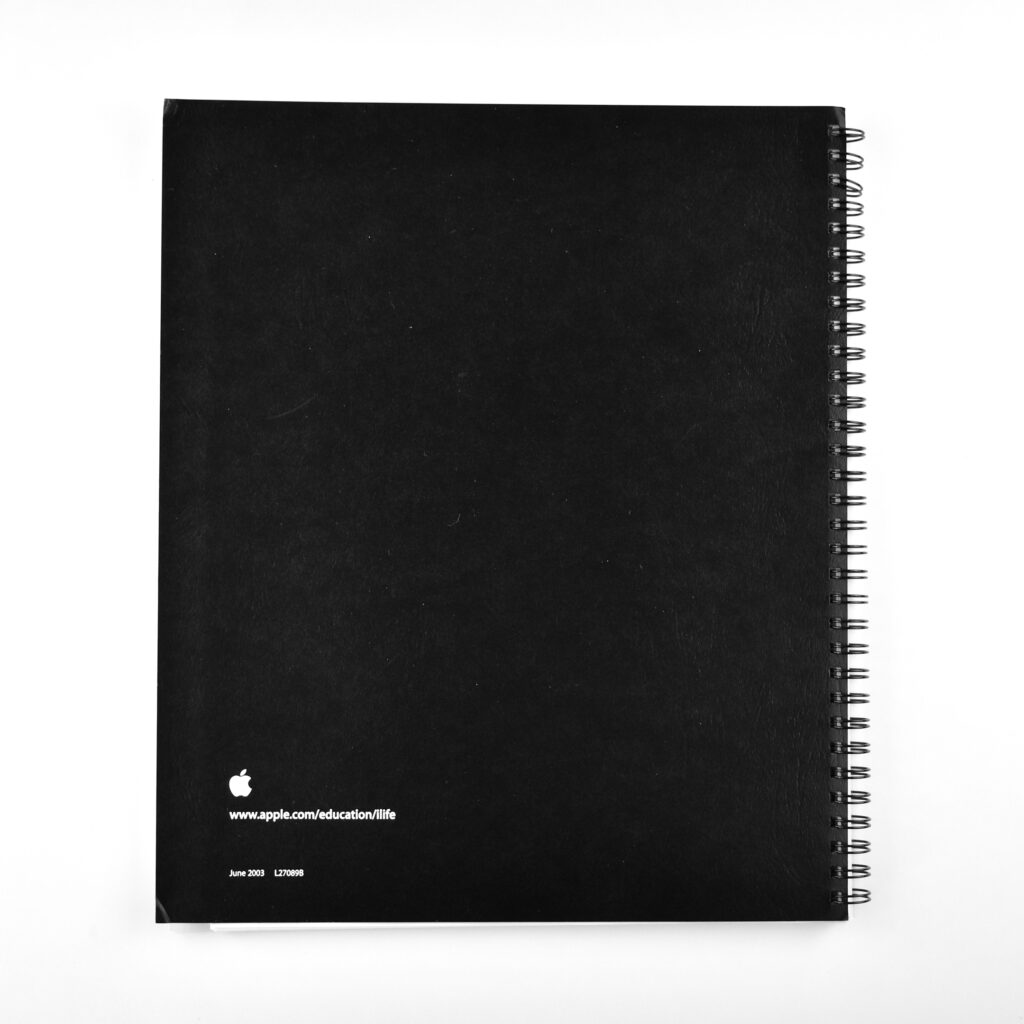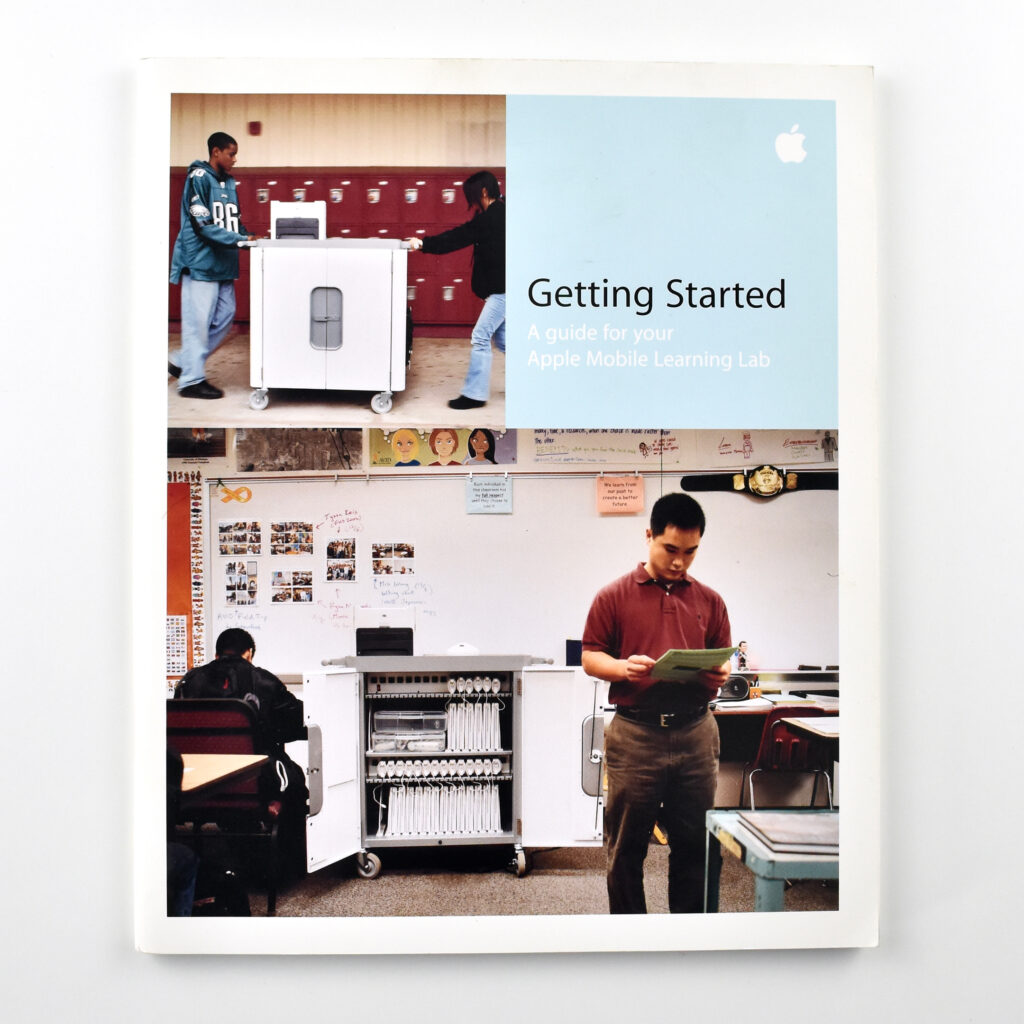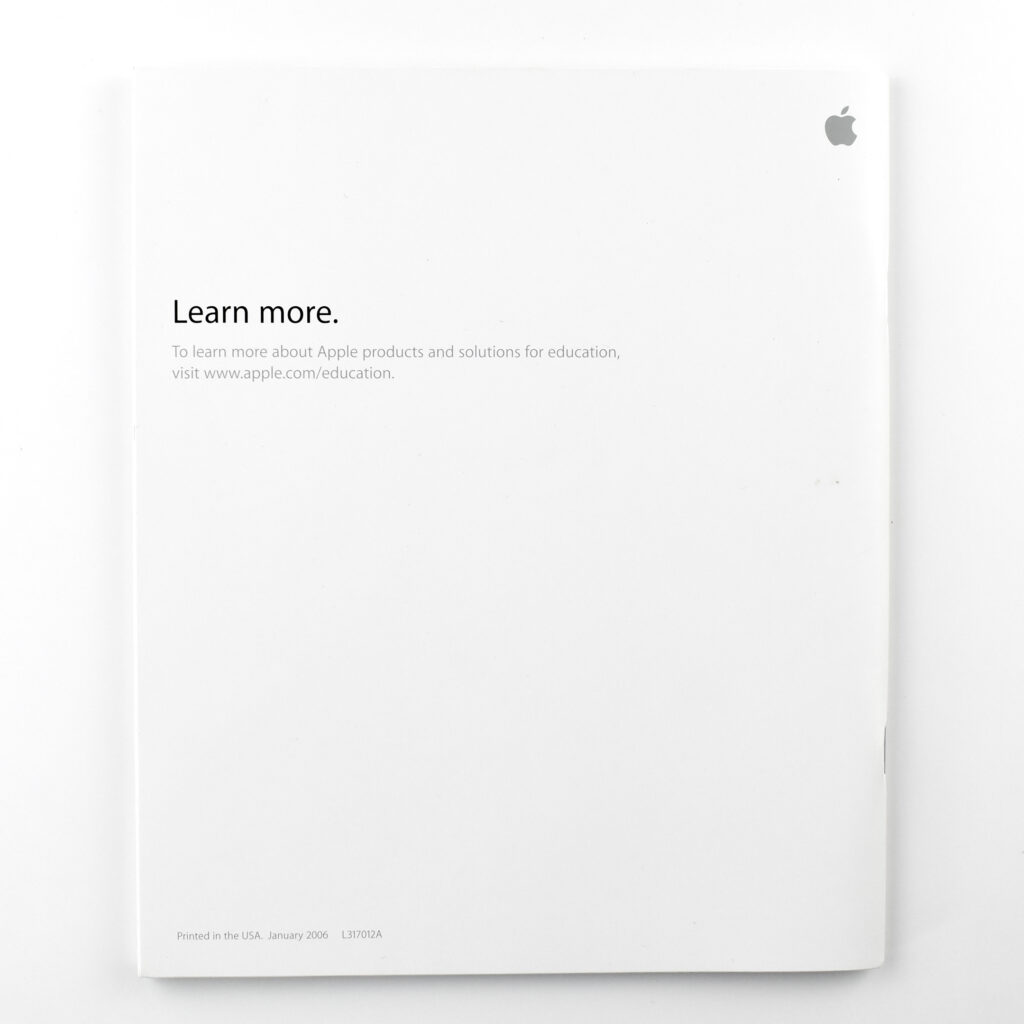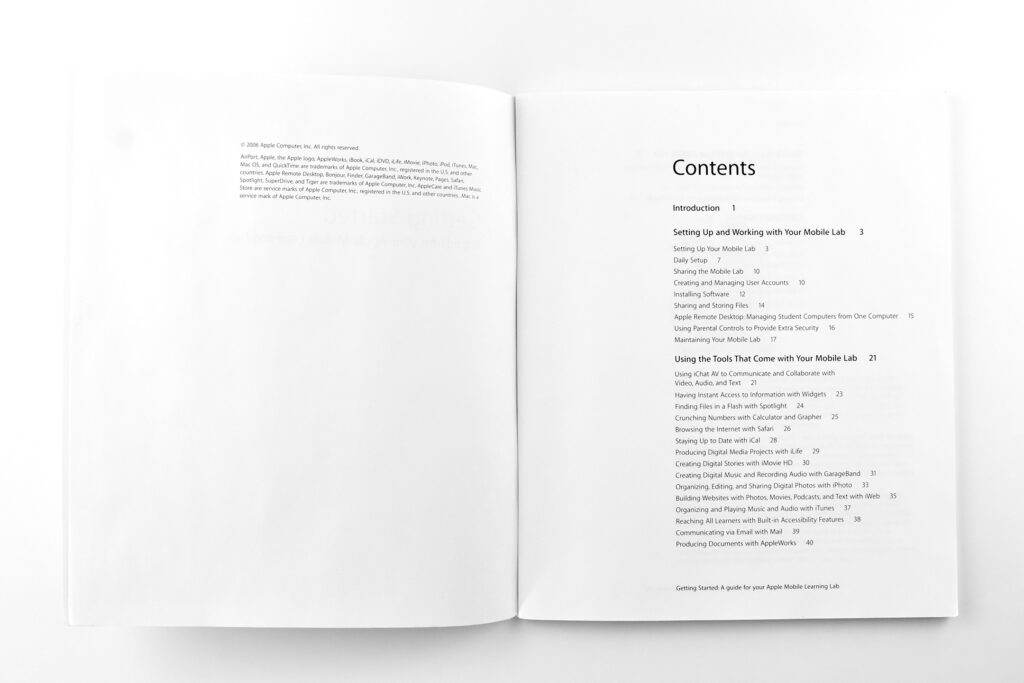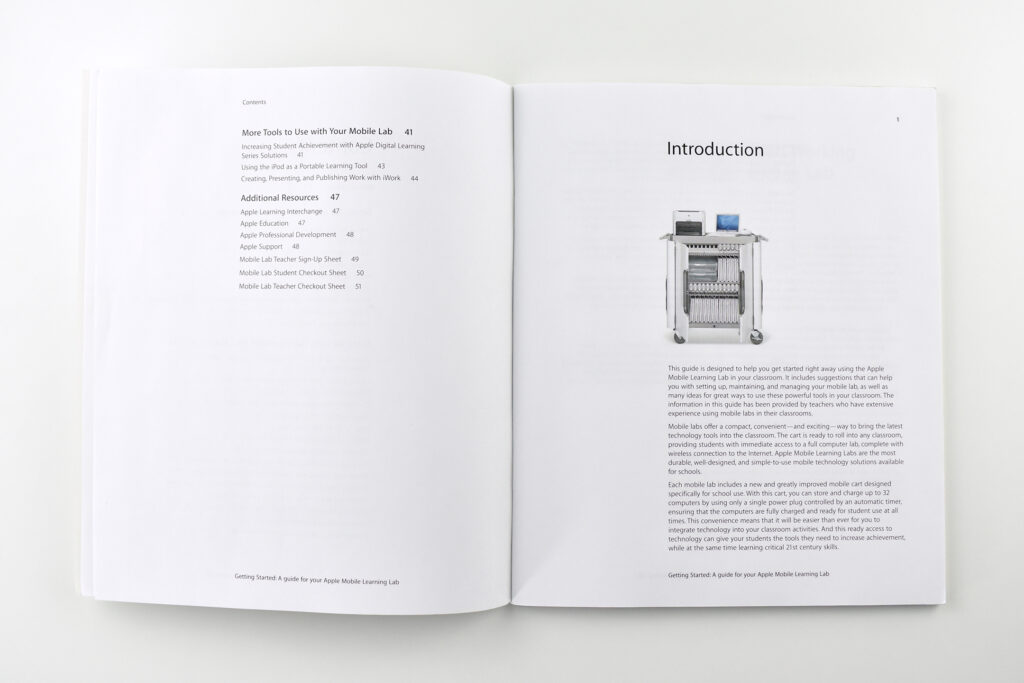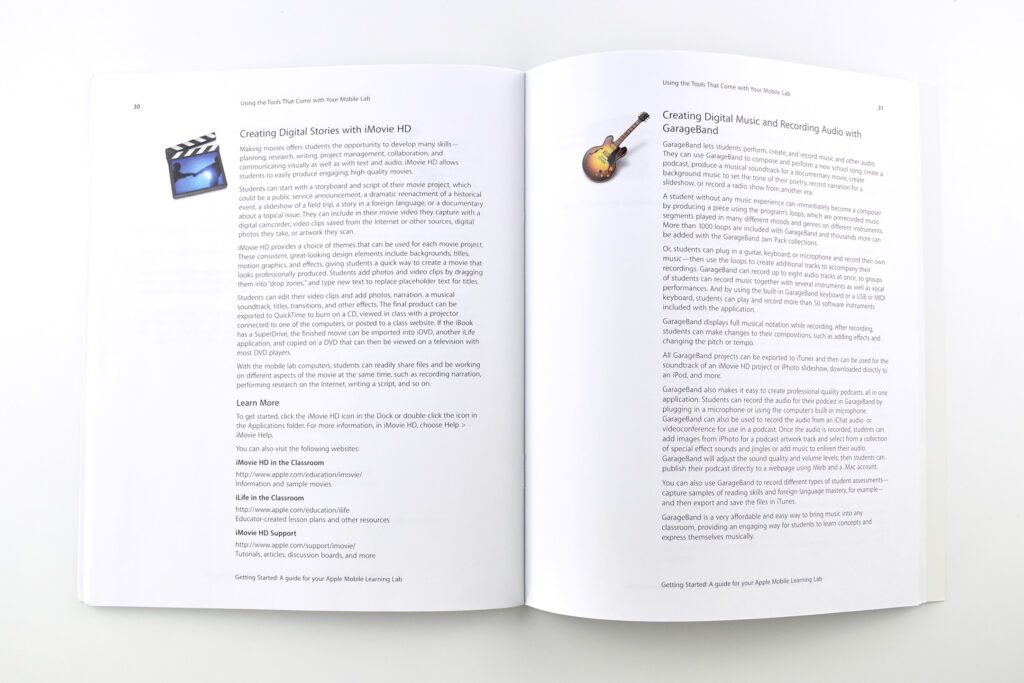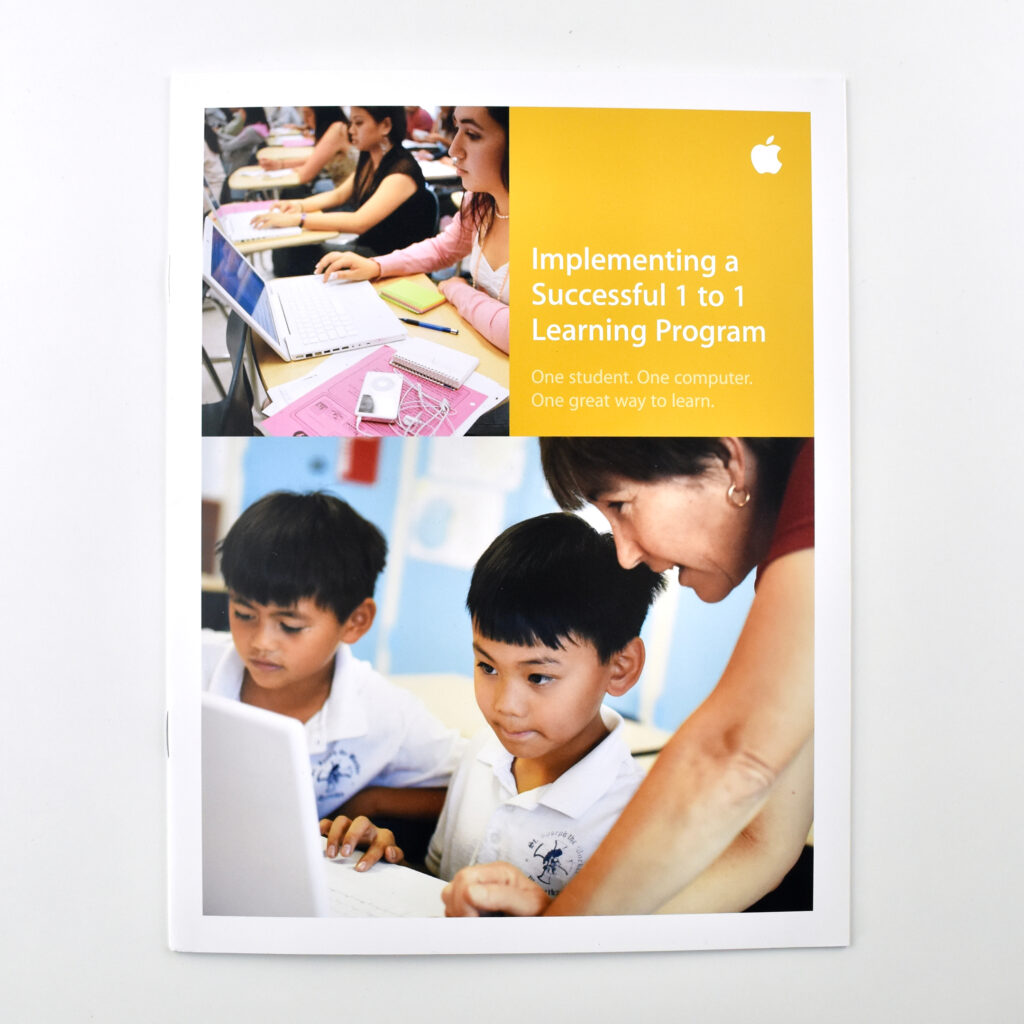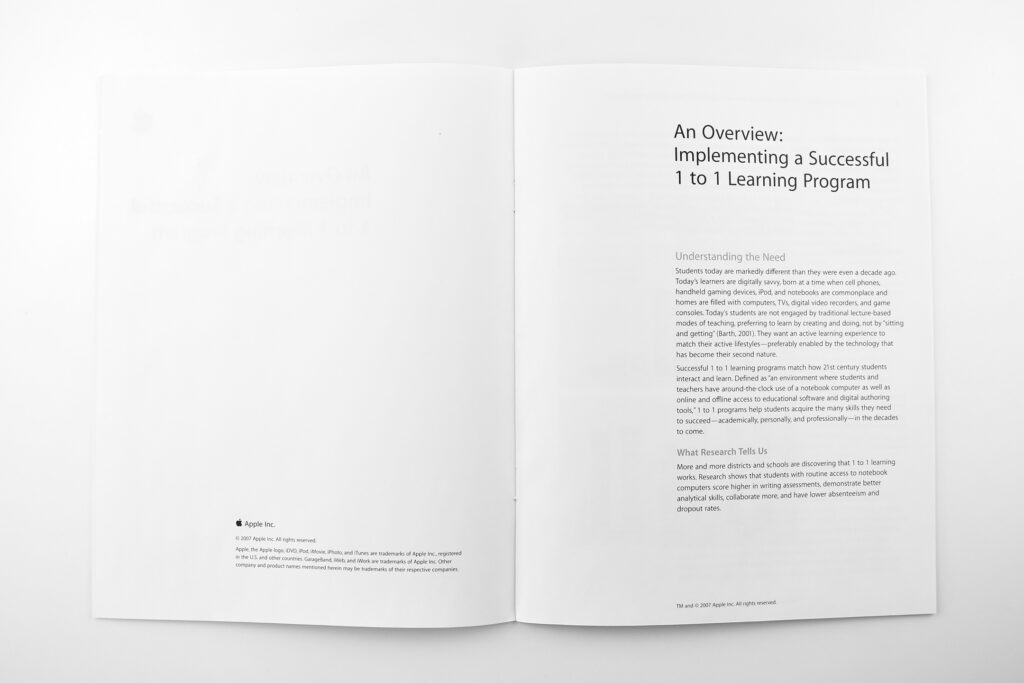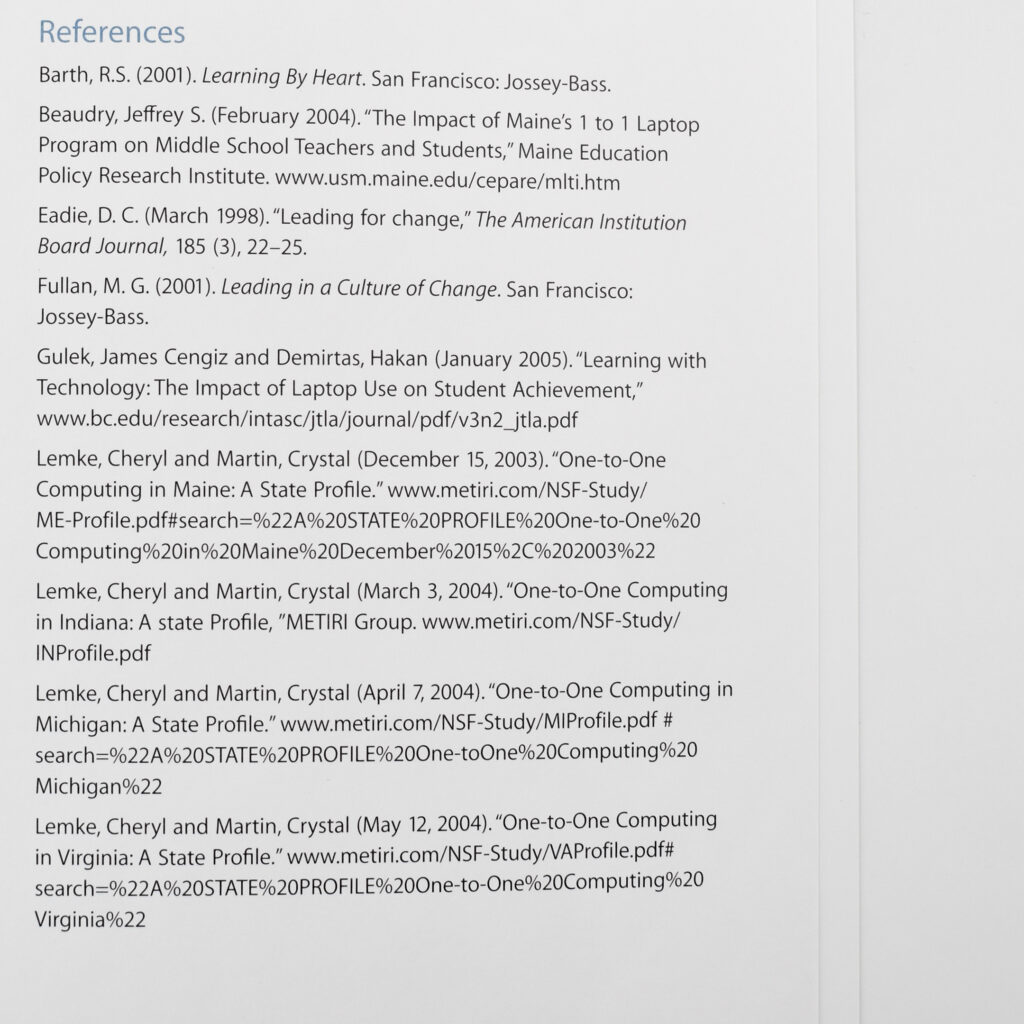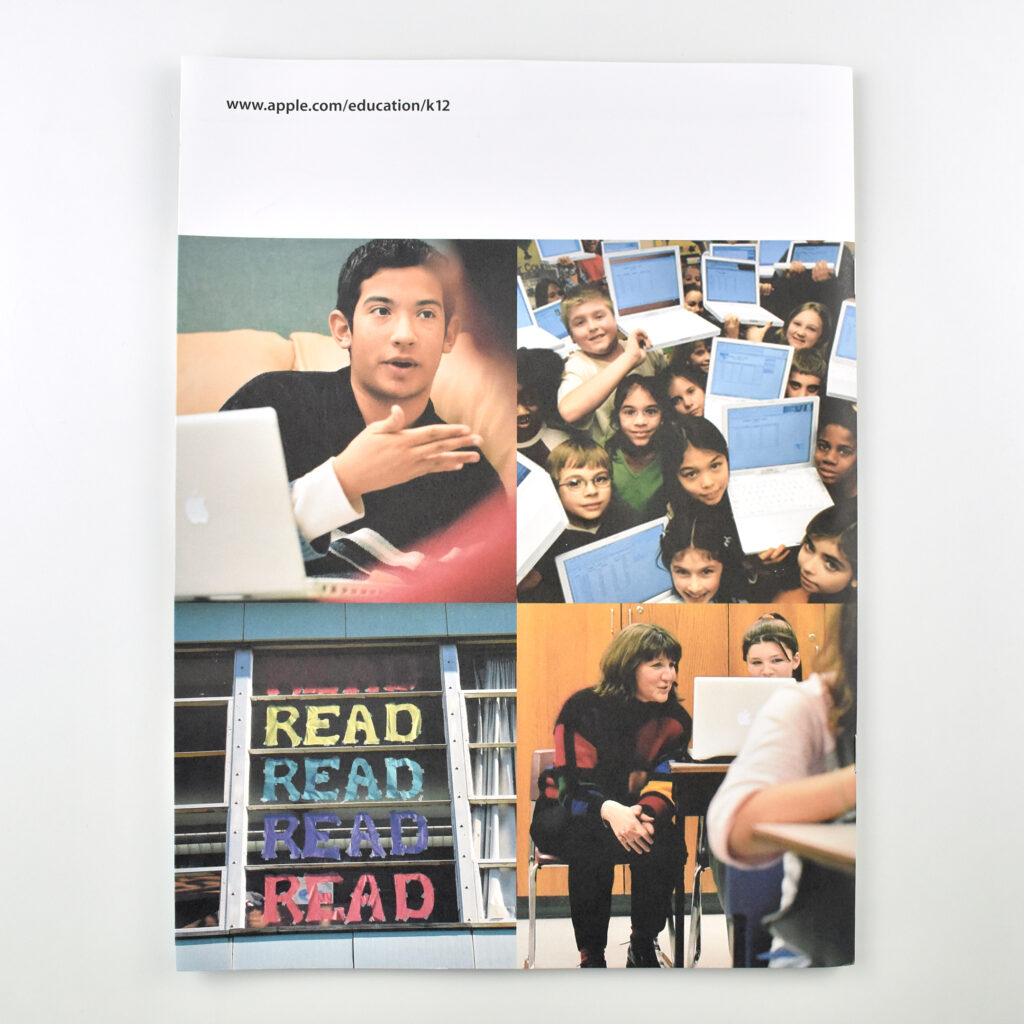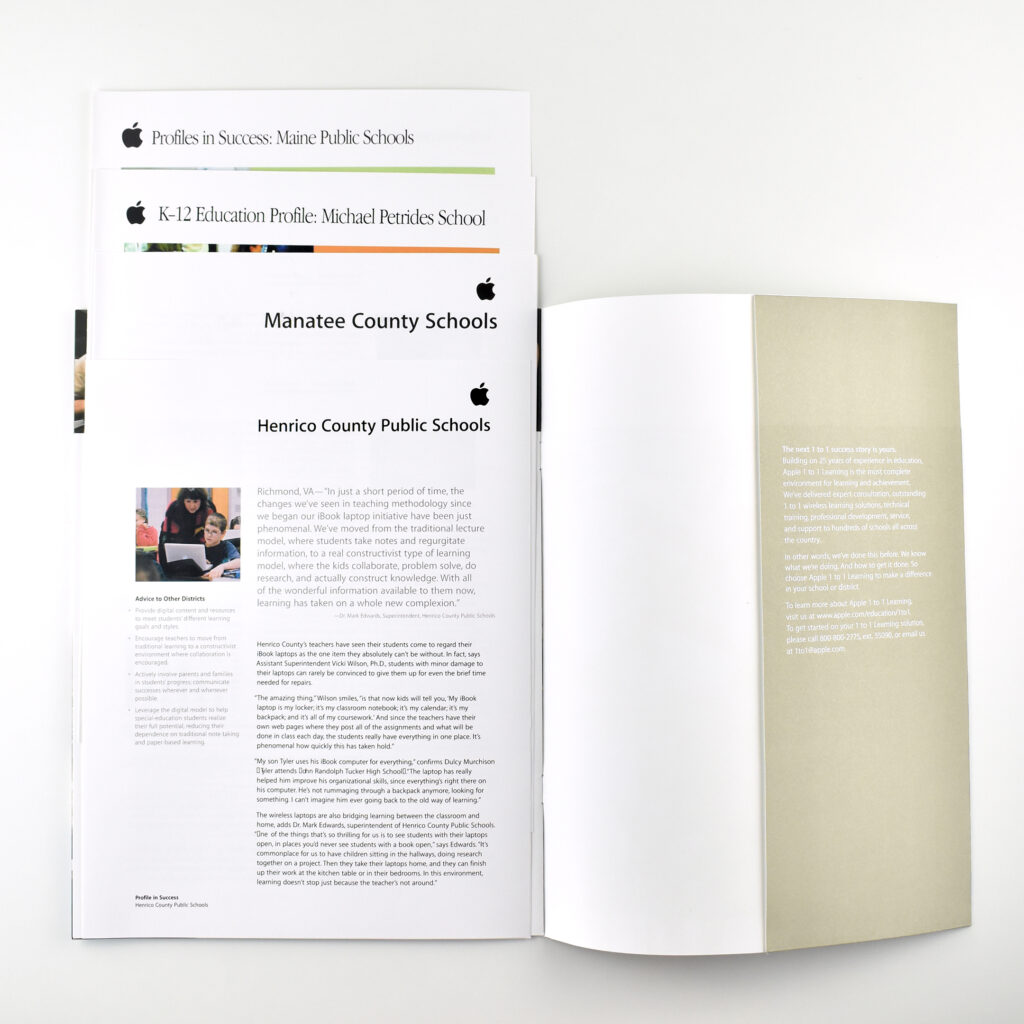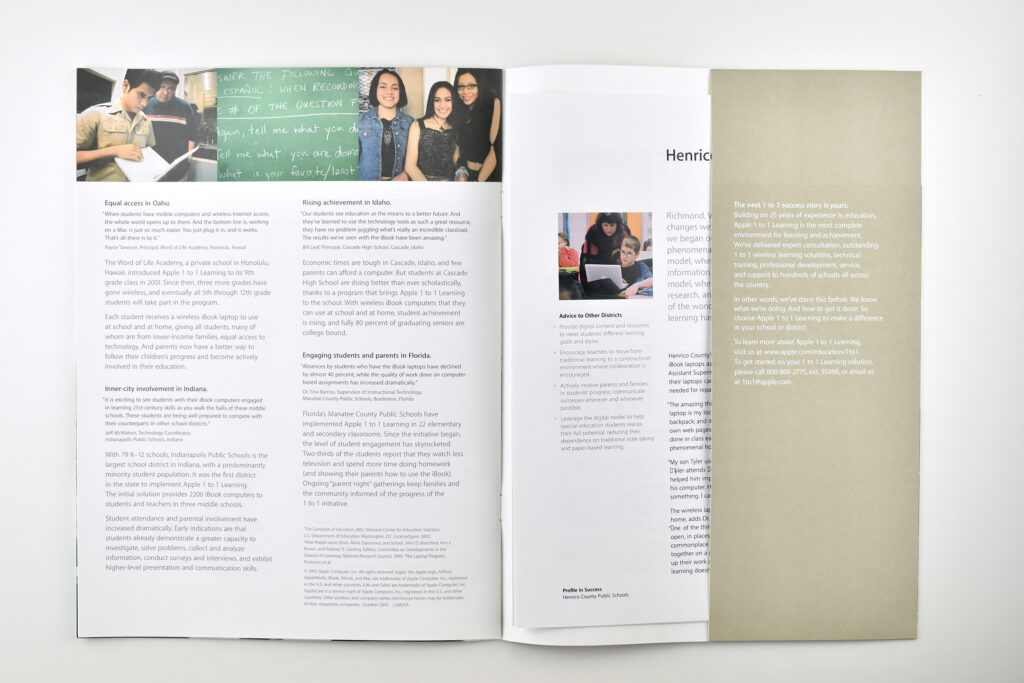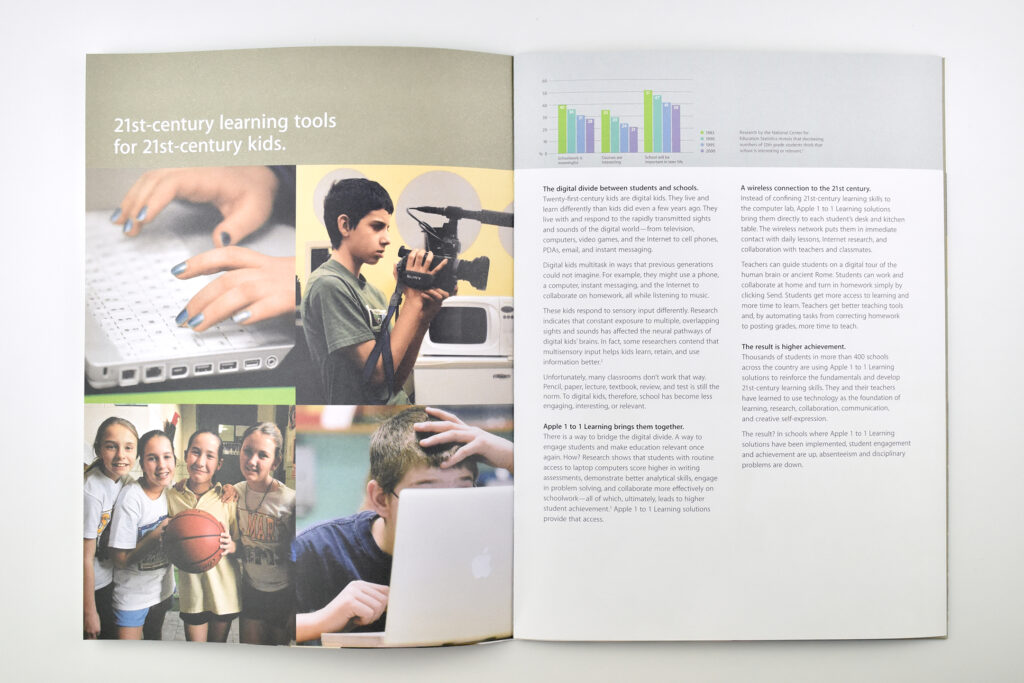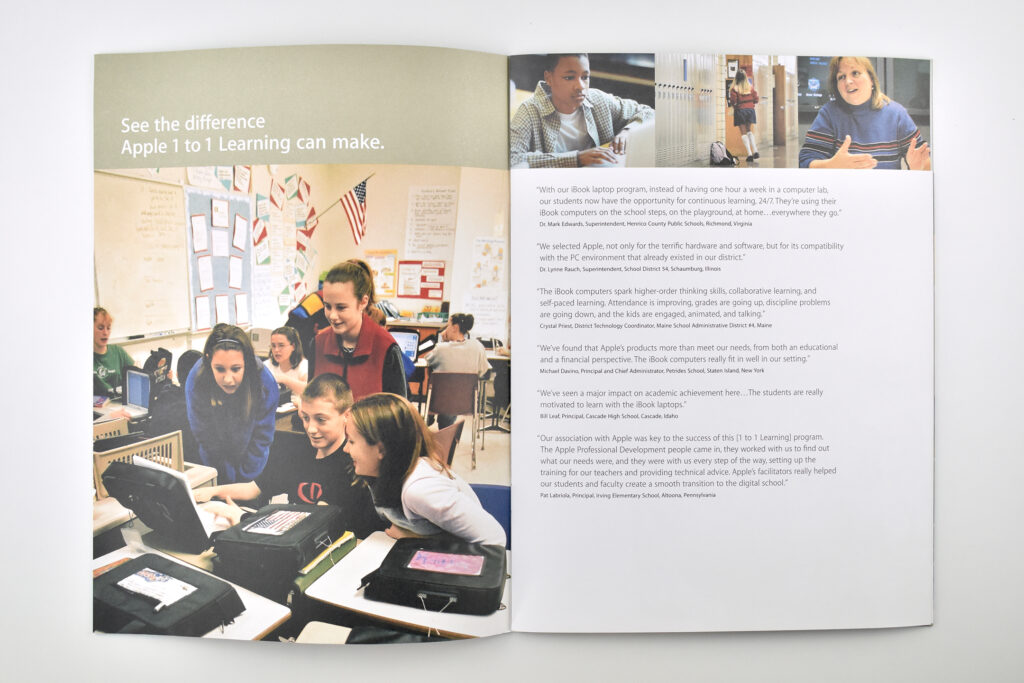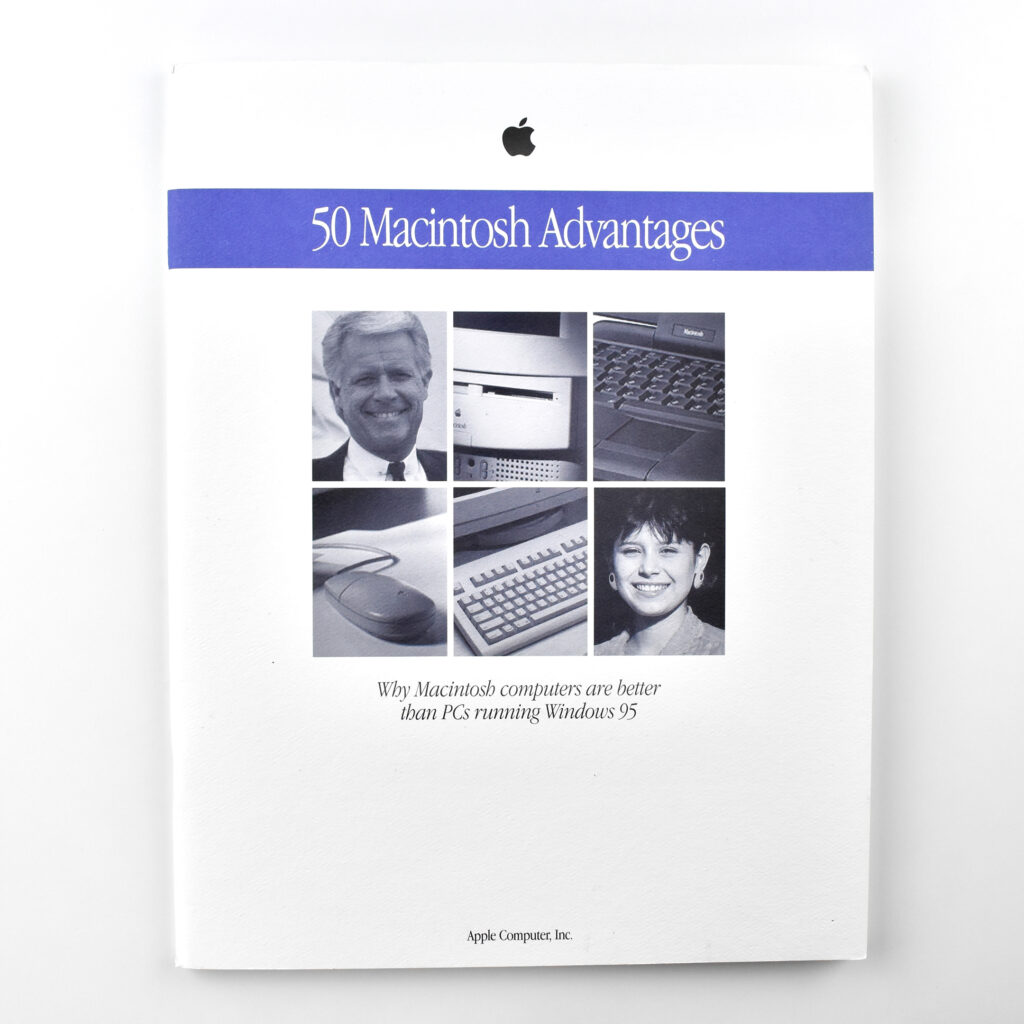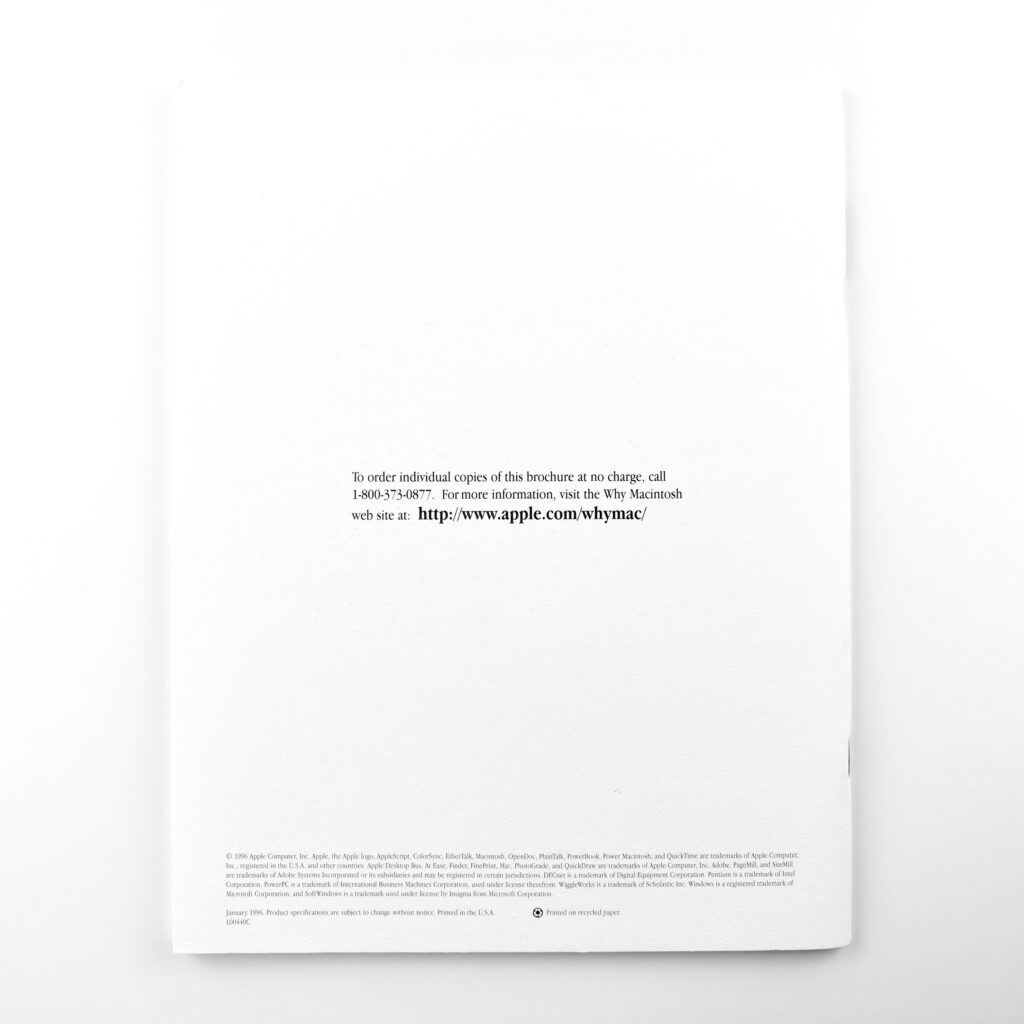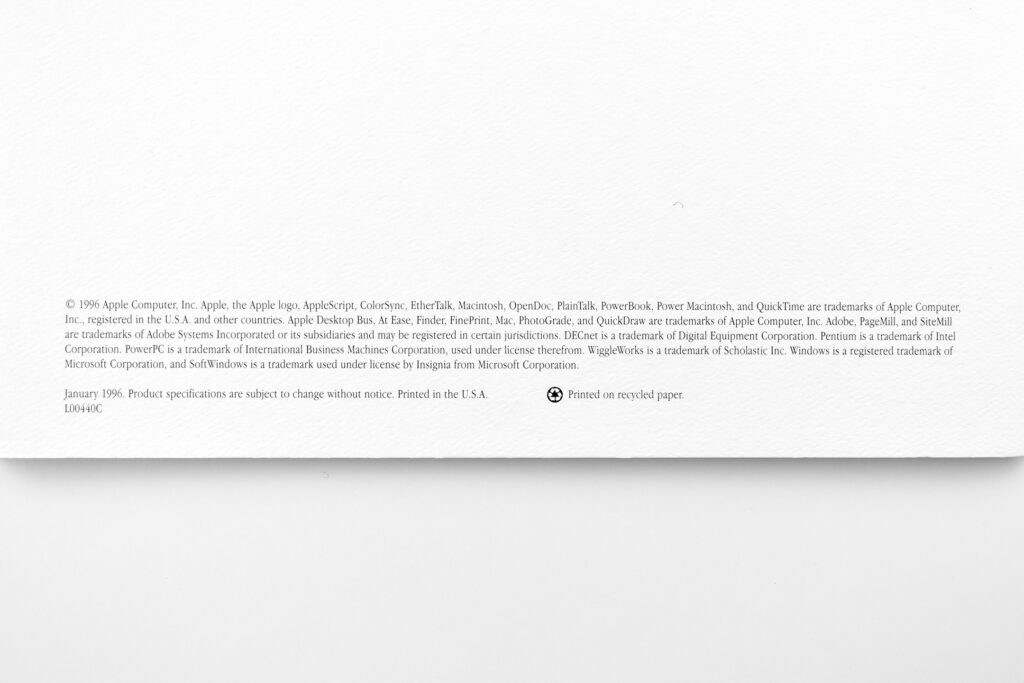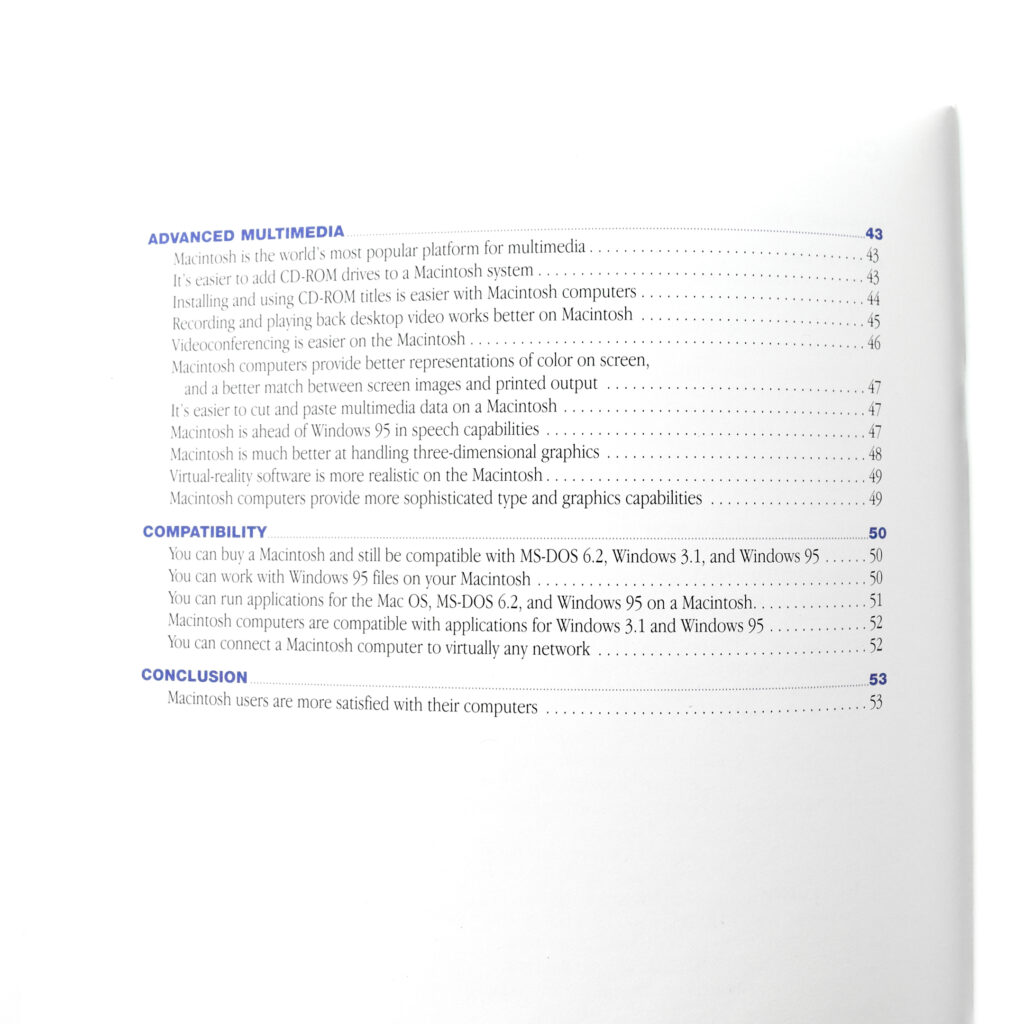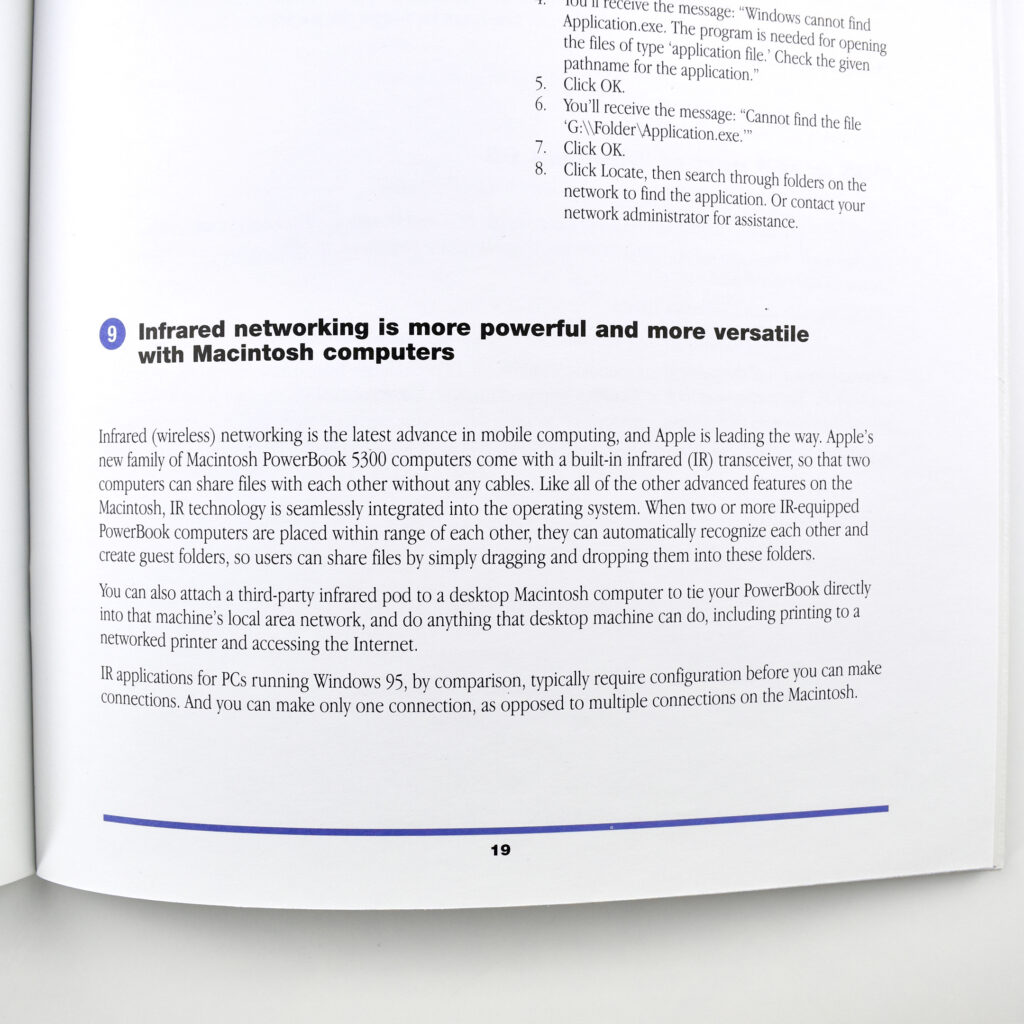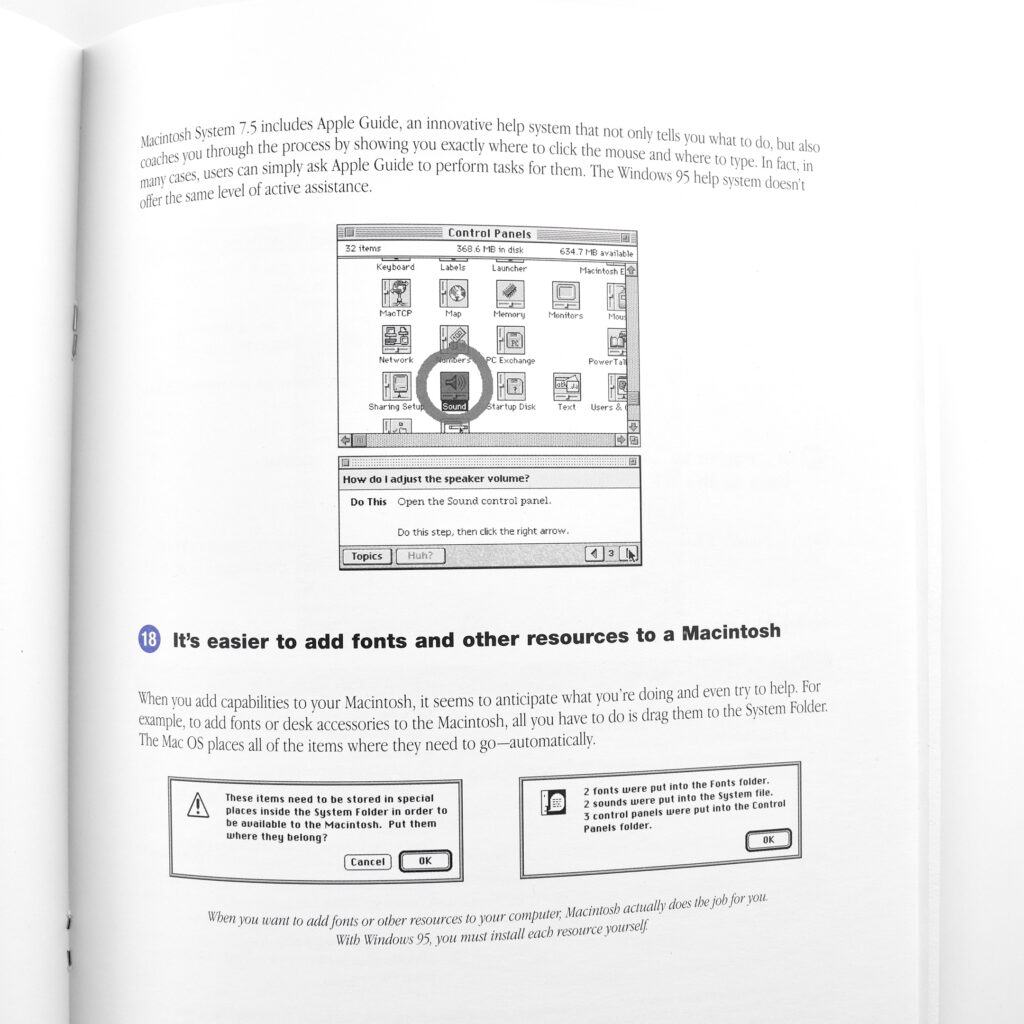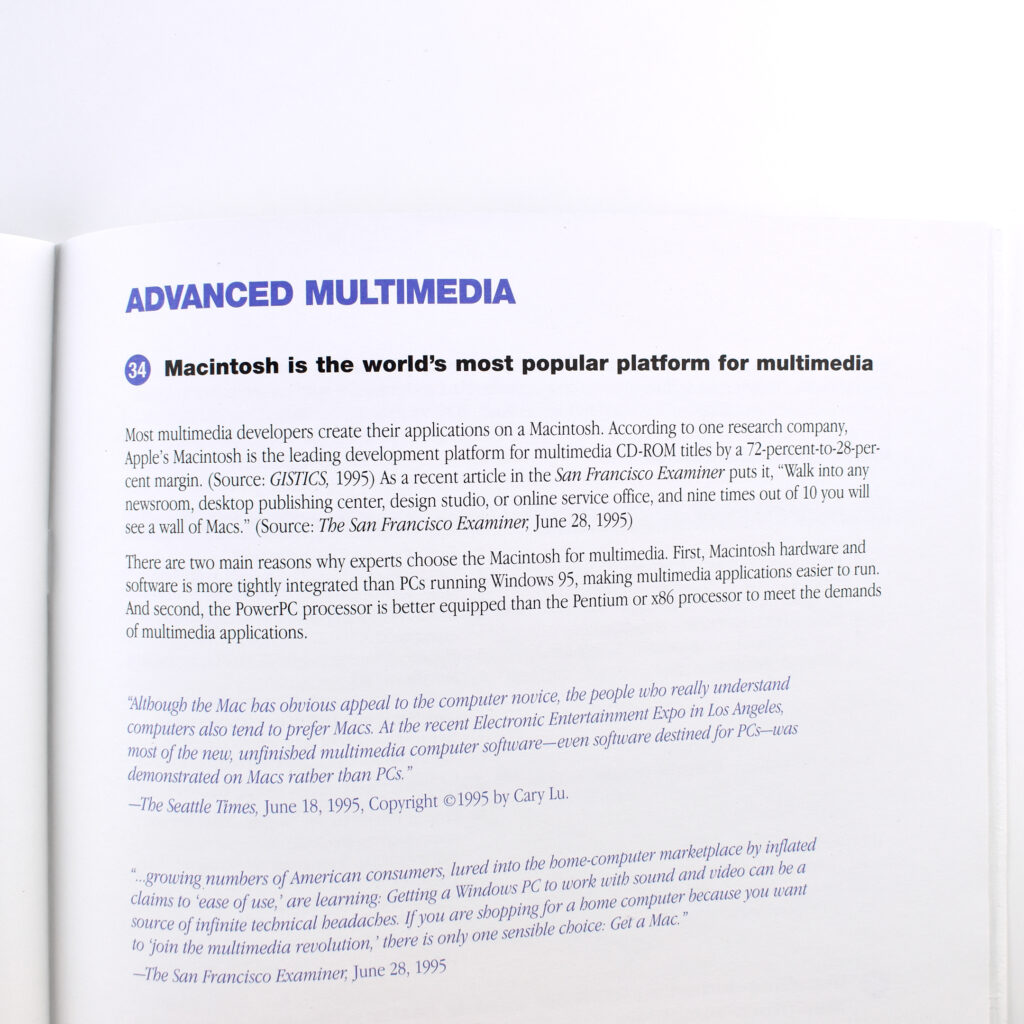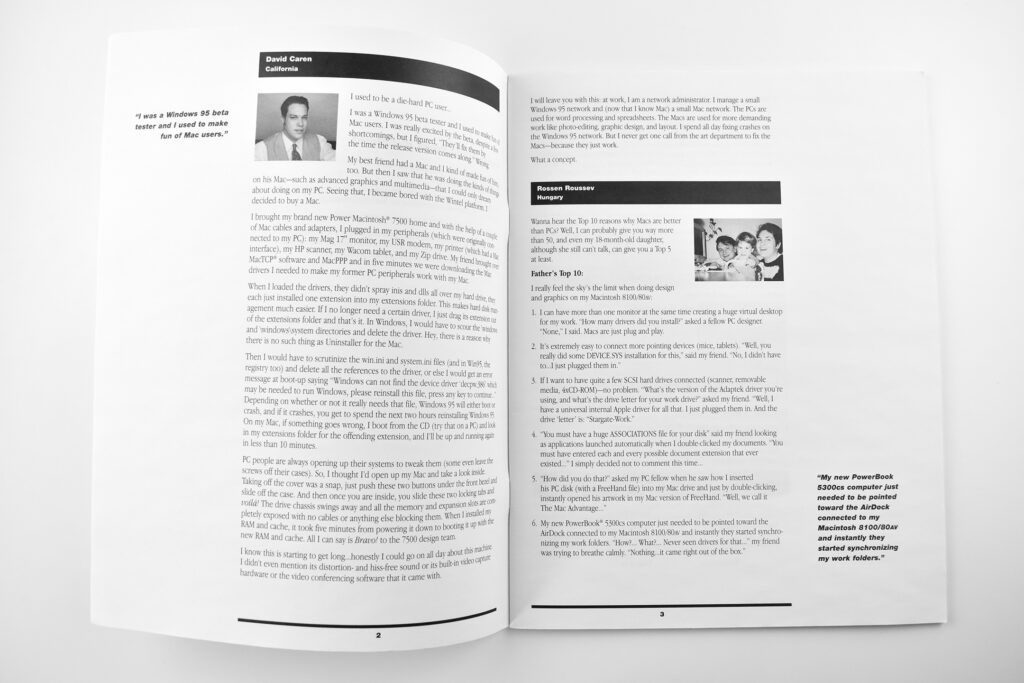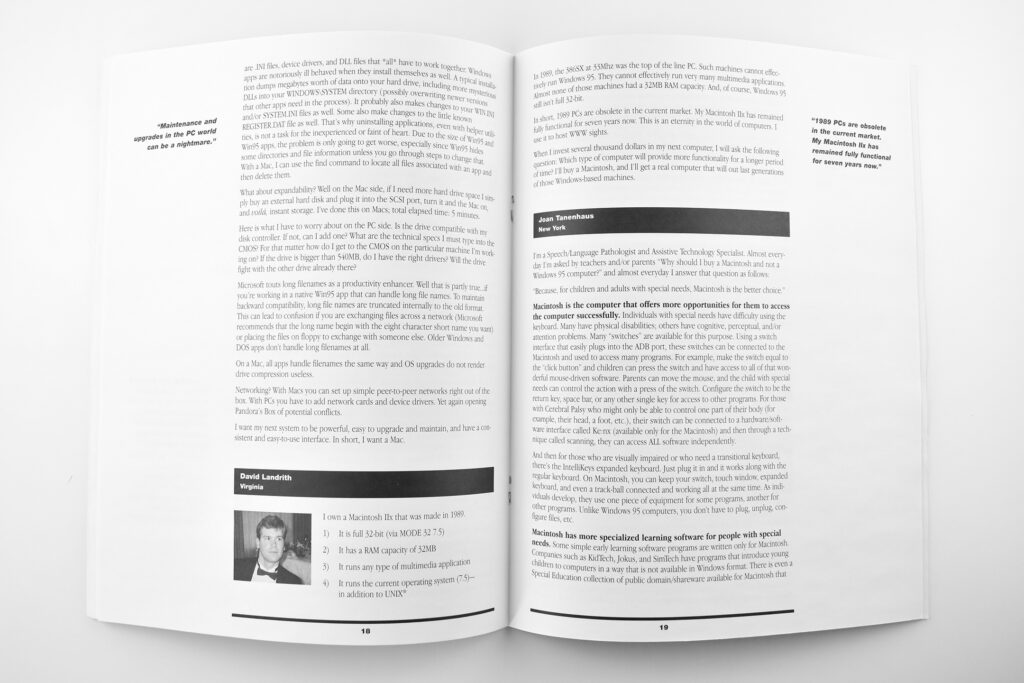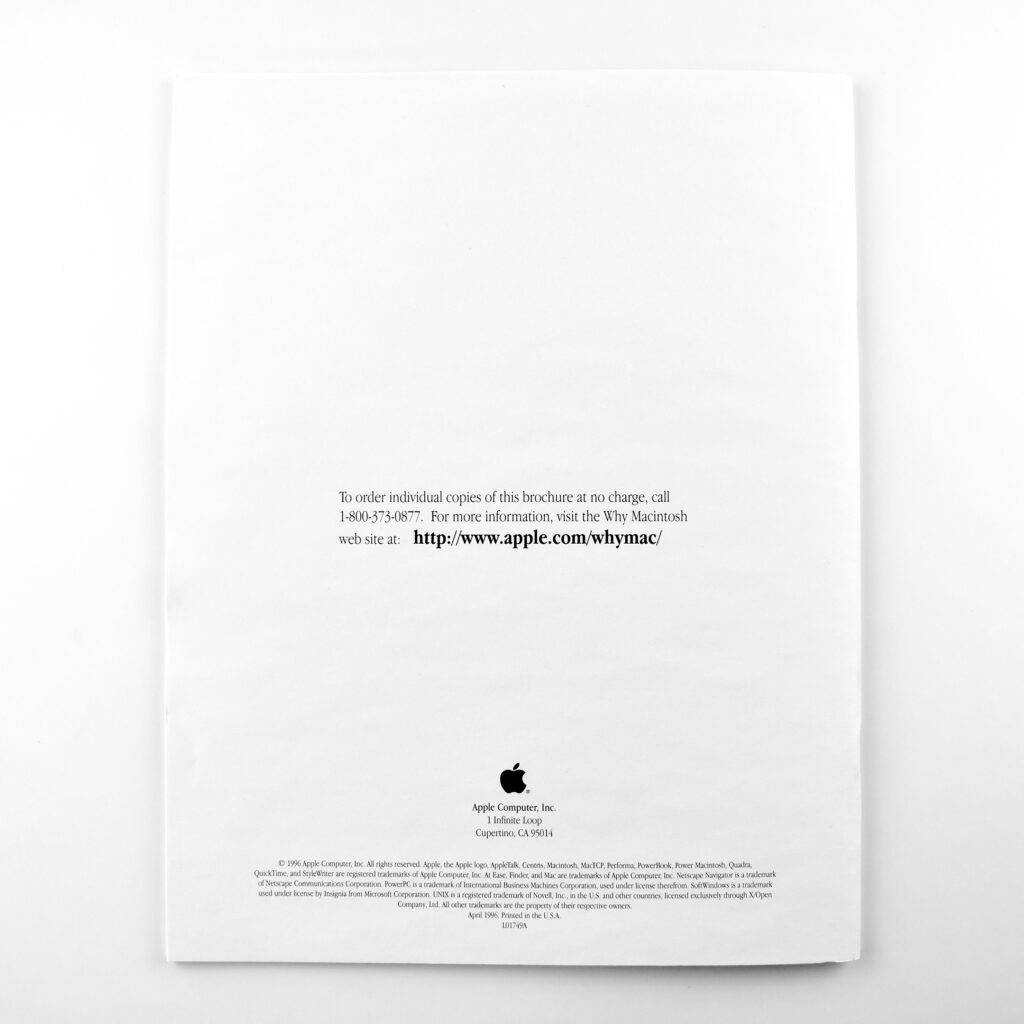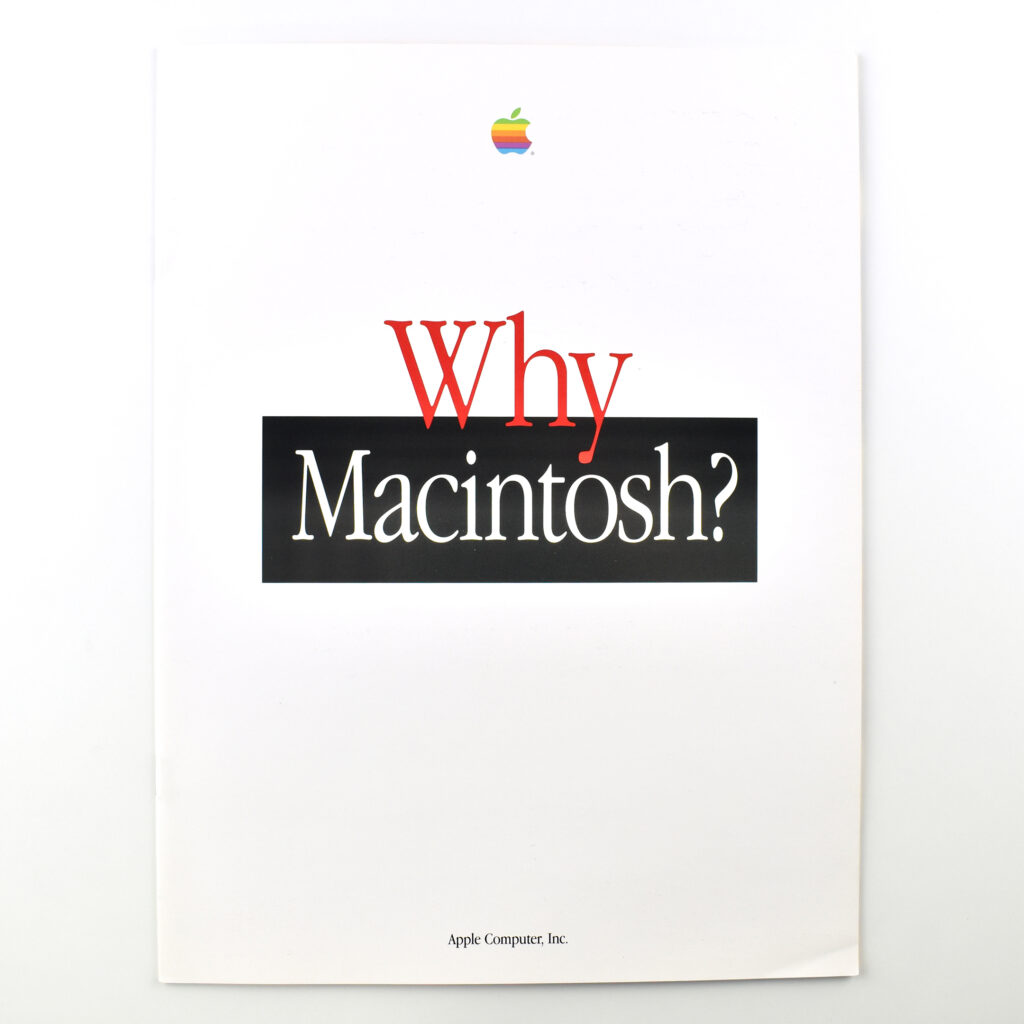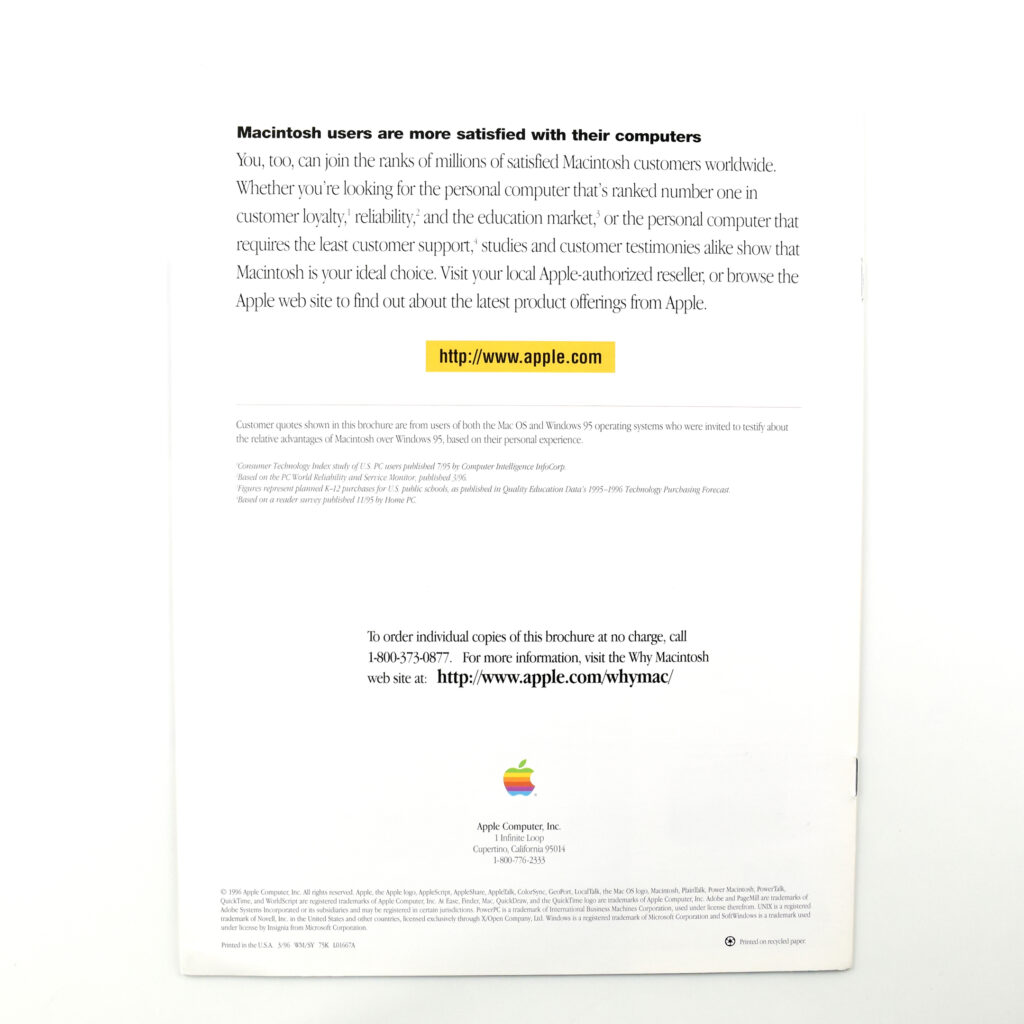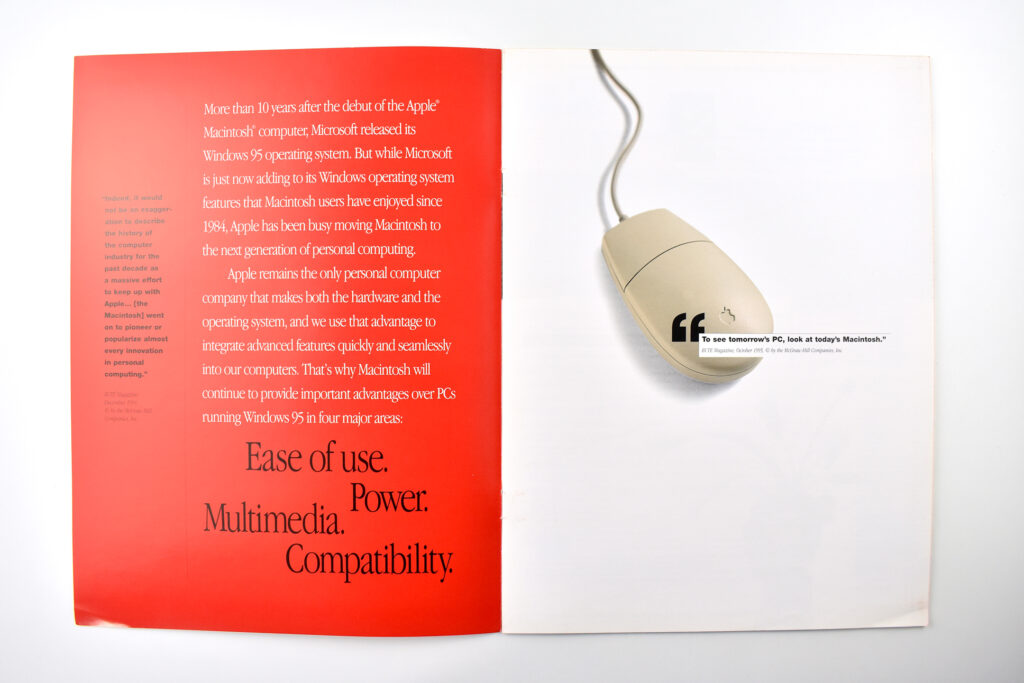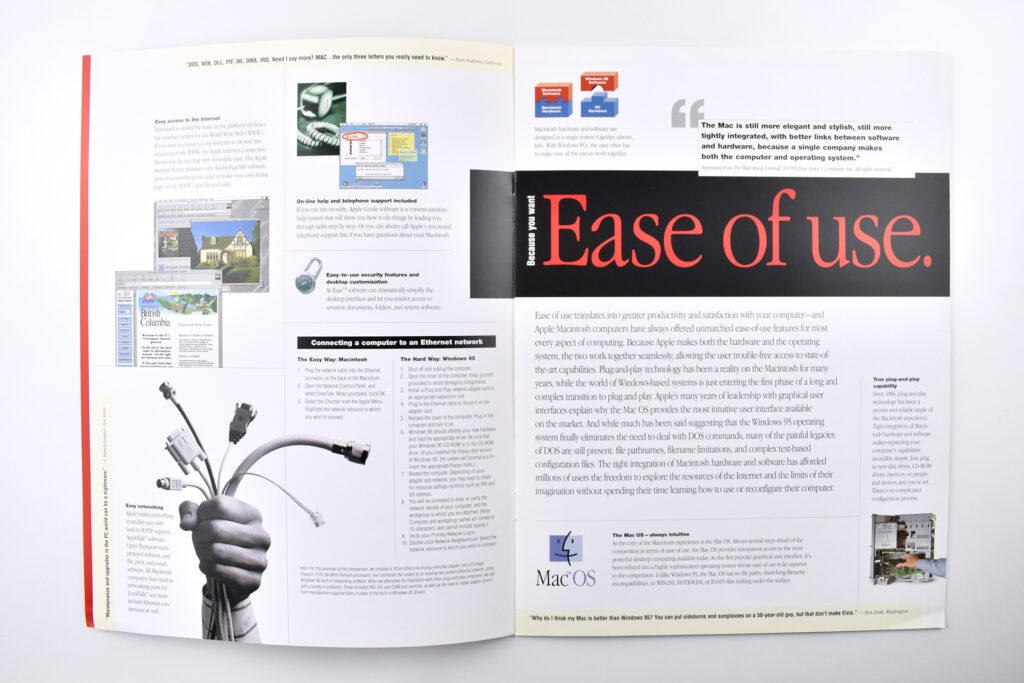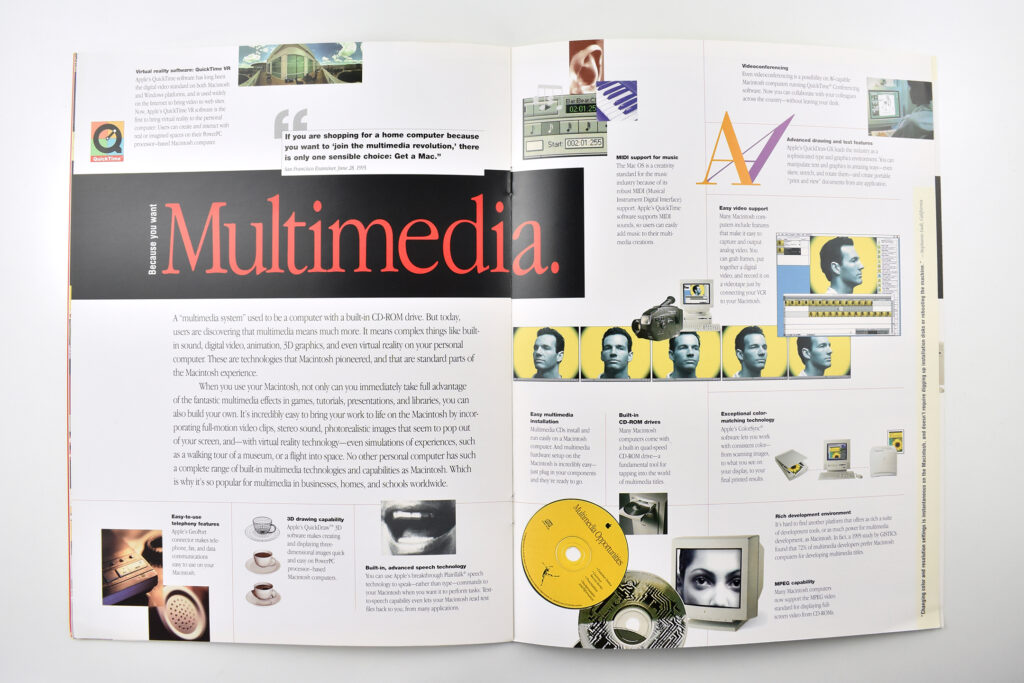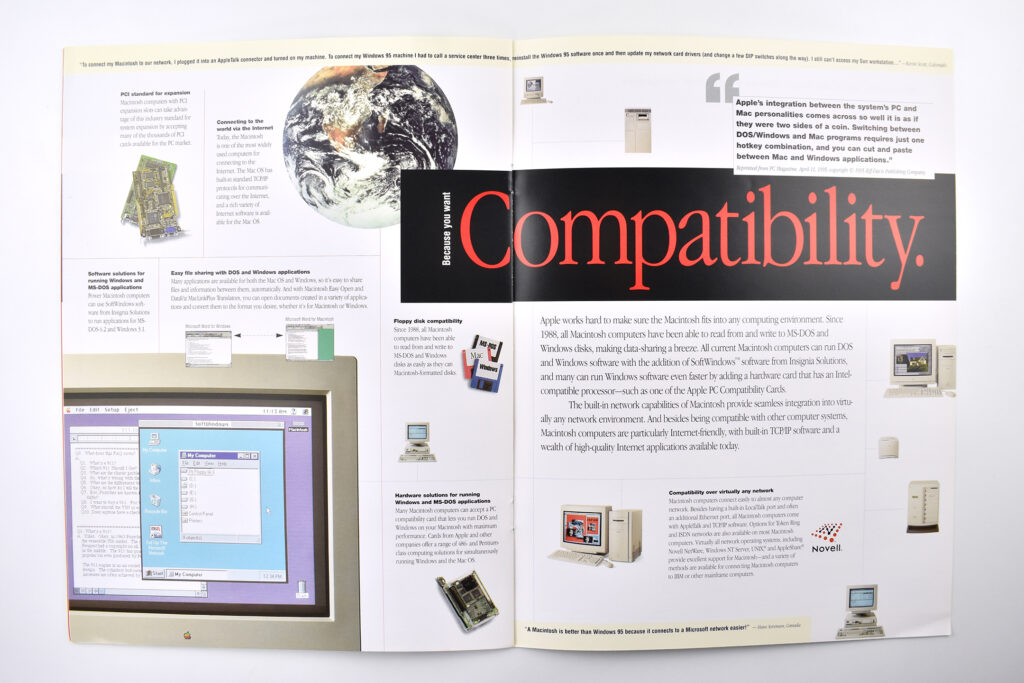Like all original M1 iMac models, the pink option ships with a color-matched Getting Started booklet and two stickers that match the exterior colors of the iMac. In this case, the stickers are pink and red. Both sticker colors have a slight metallic look.
We only get one chance Apple Education brochure (2002)
This Apple Education brochure was printed on heavy matte paper and featured an idealized message aimed at educators to introduce a vision of a digital-age classroom. All photography in the book features real students in classroom environments and is printed using full-page bleeds (all photos go all the way to the edge of the pages with no borders).
The cover begins with the text “We only get one chance,” and the first two-page spread continued, “to engage them, to set them on the right path, and to prepare them for a world none of us can possibly predict.” The next spread begins with the question “So, what will we do with this chance?”
The next pages are two-page spreads with a full-bleed photo on one side and information on the facing page discussing several categories including Mobile Computing, Wireless Networking, Digital Media, PowerSchool (a student information system no longer owned by Apple), and Apple’s Comprehensive Services.
The final page features a green Apple logo with contact information.
This brochure measures 8 x 11 inches and has 16 pages.
iLife. For the classroom. books (2003)
Two books with the same cover photo (three girls filming themsleves with a DV camera) are headed with “iLife. For the classroom.” and titled, Engage and motivate students with Apple’s new suite of integrated digital media software. The books are spiral bound, have a clear plastic cover, and five tabbed sections. One book is divided into the sections Language Arts/Literacy, Math, Science, Social Studies, and Other. The second version of the book replaces the “Other” tab with a “Step by Step” tab.
The first section of the book is printed in color and describes the iLife suite as “Tools that power today’s classroom.” Each tabbed section’s pages is printed in black and includes projects created by educators including a Project Description, Outcomes, Technology Skills, Tools and Resources, Assessment Suggestions, Tech Tips, and more.
Many of these activities were written by my friends who are teachers and Apple Distinguished Educators.
The pages measure 8.5 x 11 inches, are spiral bound, and the tabs add an extra 0.5 inch—making the full book 9 x 11 inches. Each section of these books is paginated separately. The March 2003 edition has approximately 68 pages and the June 2003 edition has approximately 82 pages.
Getting Started: A guide for your Apple Mobile Learning Lab (Apple Education, 2006)
In the book Getting Started: A guide for your Apple Mobile Learning Lab, Apple Education outlines the necessary steps to successfully implement a mobile computer cart outfitted with laptops, Wi-Fi, and other equipment. The book also provides basic training on Mac apps and gives ideas about how to use the laptops in the classroom.
The introduction states:
“This guide is designed to help you get started right away using the Apple Mobile Learning Lab in your classroom. It includes suggestions that can help you with setting up, maintaining, and managing your mobile lab, as well as many ideas for great ways to use these powerful tools in your classroom. The information in this guide has been provided by teachers who have extensive experience using mobile labs in their classrooms.”
The chapters include:
- Setting Up and Working with Your Mobile Lab
- Using the Tools that Come with Your Mobile Lab
- More Tools to Use with Your Mobile Lab
- Additional Resources
This book measures 9 x 7.5 inches and has 51 pages.
Apple Education 1 to 1 planning resources collection (2006, 2007)
From the mid-1980s to early 2000s, many schools had computer labs where students took computer classes or completed class projects. In general, students used computers at scheduled times during the school day. In the early 2000s, laptop carts became common so instead of going to the computer lab, the computer lab could go to your class.
In the early- to mid-2000s some schools had taken the leap to provide a laptop to every student throughout the school day. At first, these “1 to 1” (or 1:1) programs—one computer per one student—were rare and schools that implemented the programs only allowed students to use laptops while in school. Slowly, 1:1 programs allowed students to take home laptops some or all the time.
Around 2005, Apple Education began creating materials to help schools and school districts create 1:1 computer programs. These two paperback books are examples of Apple Education’s planning materials for school leaders.
In the short, but well-referenced brochure, Implementing a Successful 1 to 1 Learning Program, Apple makes the case for a 1:1 implementation:
“Students today are markedly different than they were a decade ago. Today’s learners are digitally savvy, born at a time and cell phones, handheld gaming devices, iPod, and notebooks are commonplace in homes are filled with computers, TVs, digital video recorders, and game consoles. Today’s students are not engaged by traditional lecture-based modes of teaching, preferring to learn by creating and doing, not by ‘sitting and getting’ (Barth, 2001). They want an active learning experience to match their active lifestyles—preferably enabled by the technology that has become their second nature.”
This brochure measures 7 x 9 inches and 9 pages long.
Another resource for 1:1 planning was a folder-sized brochure with 8 color pages. The brochure is titled One student. One computer. One great way to learn. The first page is a series of quotes by education leaders across the United States, and the rest of the brochure includes information in three more categories: 21st century learning tools for 21st century kids. A complete environment for learning and achievement. Higher achievement, from Maine to Hawaii.
The back page of the folder included a flap to store a series of “Profiles in Success.” The profiles included in my version are: Henrico County Public Schools (Richmond, VA); Manatee County Schools (Bradenton, FL); Michael Petrides School (Staten Island, NY); and Maine Public Schools.
This folder is full color and measures 9 x 12 inches.
Macintosh Advantage Collection (1996)
Apparently, 1996 was a major year for Apple to focus on the advantages of using a Macintosh over Windows. According to EveryMac, Apple released almost 50 different Macintosh models in 1996 year including 21 Performa models, 18 Power Macintosh models, six server products, two PowerBooks (1400 model), and the Newton 130.
These three “Macintosh advantage” resources used facts, quotes, and testimonials to highlight the pros of using a Macintosh.
50 Macintosh Advantages book (1996)
The book titled 50 Macintosh Advantages is unambiguously subtitled, “Why Macintosh computers are better than PCs running Windows 95.” The book is divided into four sections, including Ease of Use, Power, Advanced Multimedia, and Compatibility. Each of the 50 advantages begins with a statement and is followed by an explanation—and often includes a screen capture or other supporting visuals. Quotes and testimonials are also included throughout this two-color-printed book (printed in black and dark purple). The 50 advantages listed in the book (from the Table of Contents) include:
- Floppy disk management is easier with Macintosh computers.
- Checking memory is easier on a Macintosh.
- Macintosh computers offer more flexible monitor support.
- Changing your mouse is easier and faster on a Macintosh.
- Macintosh menus scroll, so they’re easier to use than Windows 95 menus.
- Macintosh supports plug-and-play peripherals today.
- Macintosh computers are easier to network.
- The Mac OS keeps track of files and applications over a network.
- Infrared networking is more powerful and more versatile with Macintosh computers.
- Macintosh makes Internet access and publishing easier.
- Filename limitations.
- Filename incompatibilities between Windows 95 and Windows 3.1.
- Pathname limitations.
- Macintosh files stay linked to the applications that created them with Windows 95, that isn’t always the case.
- Macintosh aliases are easier to work with than Windows 95 shortcuts.
- The complexity of the Windows 95 Registry is a disadvantage compared with Macintosh.
- The Mac OS provides active assistance: Windows 95 doesn’t.
- It’s easier to add fonts and other resources to a Macintosh.
- It’s easier to add an application to the Apple menu than to the Windows 95 Start Programs menu.
- Applications launch once on the Macintosh, with Windows 95, some applications may launch multiple times.
- It’s easier to cut and paste graphics between applications on the Macintosh.
- An advanced industrial design makes Macintosh computers easier to work with.
- The Macintosh desktop metaphor is easier to use.
- Macintosh re-sorts folders when you add a new item: Windows 95 doesn’t.
- The Macintosh Trash is easier to use.
- Easier security and customization with the Macintosh.
- Macintosh has easier access to alternate character sets.
- Macintosh computers are faster.
- The Macintosh speed advantage will increase.
- Macintosh offers 32-bit computing today, PCs don’t.
- With the RISC-based platform, Macintosh computers are better equipped to run more powerful applications.
- Macintosh has integrated scripting.
- Macintosh computers include features that cost extra on PCs.
- Macintosh is the world’s most popular platform for multimedia.
- It’s easier to add CD-ROM drives to a Macintosh system.
- Installing and using CD-ROM titles is easier with Macintosh computers.
- Recording and playing back desktop video works better on Macintosh.
- Videoconferencing is easier on the Macintosh.
- Macintosh computers provide better representations of color on screen, and a better match between screen images and printed output.
- It’s easier to cut and paste multimedia data on a Macintosh.
- Macintosh is ahead of Windows 95 in speech capabilities.
- Macintosh is much better at handling three-dimensional graphics.
- Virtual-reality software is more realistic on the Macintosh.
- Macintosh computers provide more sophisticated type and graphics capabilities.
- You can buy a Macintosh and still be compatible with MS-DOS 6.2, Windows 3.1, and Windows 95.
- You can work with Windows 95 files on your Macintosh.
- You can run applications for the Mac OS, MS-DOS 6.2, and Windows 95 on a Macintosh.
- Macintosh computers are compatible with applications for Windows 3.1 and Windows 95.
- You can connect a Macintosh computer to almost any network.
- Macintosh users are more satisfied with their computers.
This book measures 8.5 x 11 inches and has 54 pages.
Why do People Prefer Macintosh? brochure (1996)
The brochure Why do People Prefer Macintosh? is subtitled “Why people think Macintosh computers are better than PCs running Windows, in their own words.” This brochure uses many of the same “Macintosh advantages” from the source above, but presents them as case studies and testimonials by Macintosh users. Users are identified by name and state or country, and most include a photo.
This brochure measures 8.5 x 11 inches and has 35 pages.
Why Macintosh? brochure (1996)
This Why Macintosh? brochure is a marketing piece and presents bold, full-color spreads printed on glossy paper. On the first page, this brochure declares:
“More than 10 years after the debut of the Apple Macintosh computer, Microsoft released its Windows 95 operating system. But while Microsoft is just now adding to its Windows operating system features that Macintosh users have enjoyed since 1984, Apple has been busy moving Macintosh to the next generation of personal computing.”
The next four 2-page spreads each focus on an aspect of the Macintosh: Ease of Use, Power, Multimedia, and Compatibility.
This brochure measures 8.5 x 11 inches and has 12 pages.
Source: EveryMac
